EXCLUSIVE INTERVIEWS:
Dr. Tarika Barrett, CEO/Girls Who Code
Wildlife Filmmaker Bertie Gregory
EMERGING TECH TRENDS:
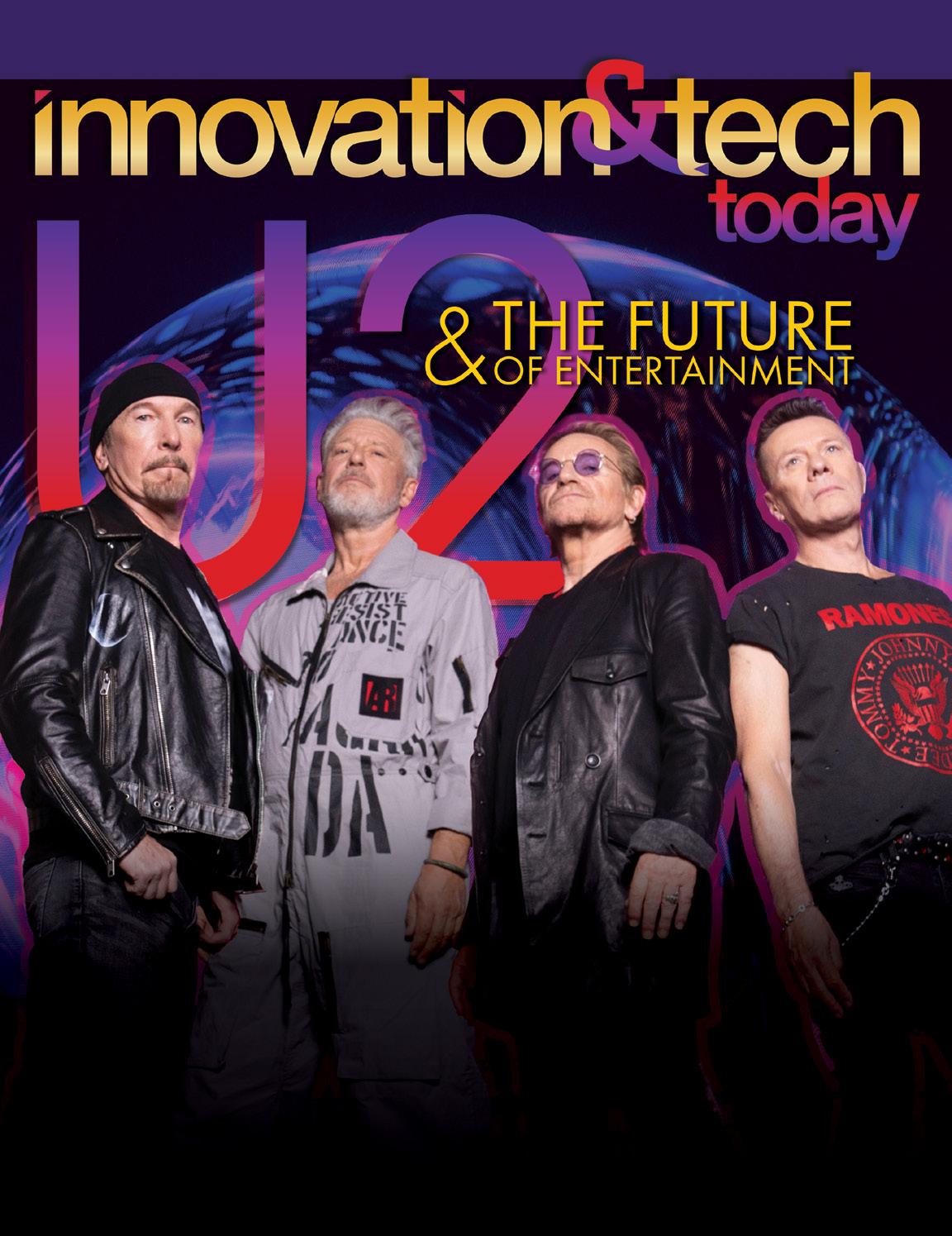
• The Adoption of ChatGPT
EXPLORE: Revolutionary Cinematography in The Creator
• VR in the Medical Field
• Benefits of the Industrial Metaverse
• Zero Emission Winnebago eRV2
• Generative AI in K-12 Ed.
• Protecting Your Medical Data
Volume 9 / Issue 2 TECH REVOLUTION UNFOLDS IN TEXAS | TOP 50 MOST INNOVATIVE PRODUCTS | AI IN HOLLYWOOD
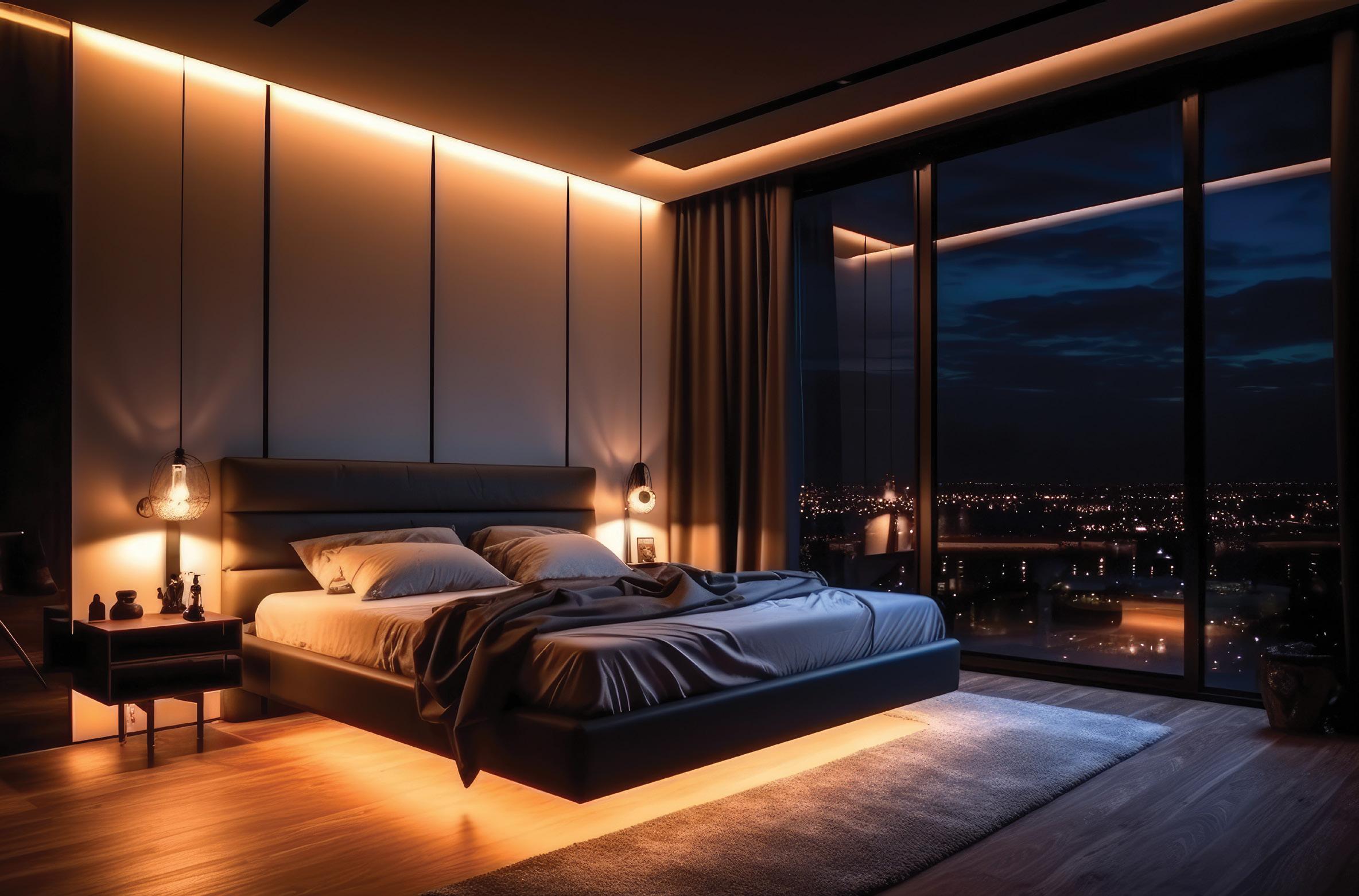
shellytech
Control Everything. Measure Everything.
Compatible with Everything.

Control scenes using Shelly BLU Door/Window
Control scenes using Shelly BLU Door/Window

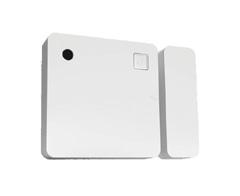
Measure your energy using our Shelly Plus Series
Measure your using Shelly Plus Series


Compatible with URC, Control4, Elan, Crestron and many other platforms
Compatible with URC, Control4, Elan, Crestron and many other platforms
Now integrates with Josh.ai and the Nimble DevSuite
Now integrates with Josh.ai and the Nimble DevSuite

Visit Shelly.com and explore the possibilities
 Charles Warner, Publisher/ Editor-in-Chief
Charles Warner, Publisher/ Editor-in-Chief
“Looking forward, the possibilities are captivating. From self-driving electric cars navigating the streets to smart cars transforming the automotive experience. This issue will ignite your curiosity and leave you more informed and tech-savvy.”
Dear Readers,
As we dive deeper into the ever-evolving landscape of technology, our focus in this edition of Innovation & Tech Today shifts from the quick progression of artificial intelligence (AI) to the realm of electric vehicles and connected cars.
Much like the surge of AI in diverse industries, the world of electric vehicles and connected cars is quickly progressing. Reports project a significant surge in global spending on electric vehicles and smart cars. We delve into the potential of AI and self-driving cars, exploring how they enhance efficiency, safety, and overall driving experience. Additionally, we look into solar-powered cars, the evolution of electric vehicle infrastructure, and more.
Issue 9.2 also features interviews with transformative individuals making a lasting difference in the technology industry. CEO of Girls Who Code, Dr. Tarika Barrett, spoke on closing the gender gap, CEO of Smileyscope, Evelyn Chan, shared her thoughts on tech’s role in the medical field and how VR is changing the pediatric experience and Wildlife Filmmaker Bertie Gregory discussed the filming experience of his new series on Disney+ and National Geographic and how it’s empowering others to think more sustainably.
We also present our annual Top 50 Most Innovative Products list, a testament to the cutting-edge products shaping our future. The issue also covers CES 2024 and the cool new tech developments we saw at the event. There were things like 3D printing, 5G, virtual reality, and artificial intelligence, among many others. The magazine covers how innovative technology is changing cars and how events
such as CES have a bigger meaning than just new gadgets.
Texas was the chosen regional spotlight for its dynamic landscape. As the state continues to attract talent and investment in the tech sector, the advancement and cultural diversity positions Texas as a compelling destination for both professionals and creatives alike. We explore the Lone Star State's statistics and the qualities that make it an enticing new location for all things tech.
Our cover story features the iconic band U2 and the groundbreaking Las Vegas Sphere, capturing innovation at the corner of music and technology. The Las Vegas Sphere is the epitome of future entertainment, merging cutting-edge technology with musical artistry to create an unforgettable audience experience. We spoke with The Edge, U2’s lead guitarist, keyboardist, and backing vocalist, to discover how the rock band integrated tech, art, and musical talent for their Sphere debut. Willie Williams, the band’s creative director, also shared his experience with the design process for U2’s shows at the Sphere.
Looking forward, the possibilities are captivating. From self-driving electric cars navigating the streets to smart cars transforming the automotive experience. This issue will ignite your curiosity and leave you more informed and tech-savvy. As we continue our journey of exploring the limitless potentials of technology, we look forward to keeping you updated on the latest developments in the world of innovation.
Best,
Charles Warner
2 INNOVATION & TECH TODAY | VOL. 9 / ISSUE 2 FROM THE PUBLISHER


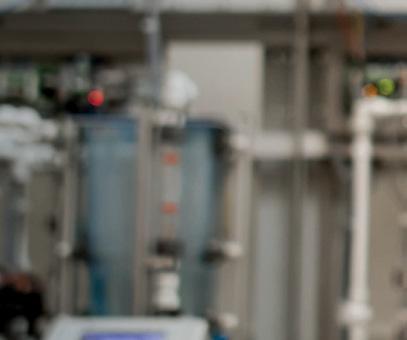








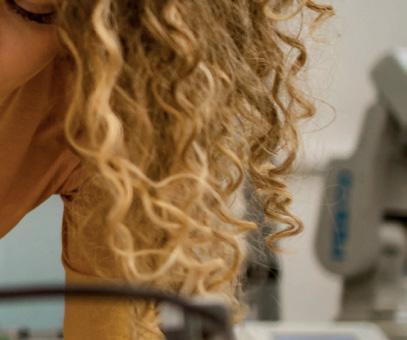
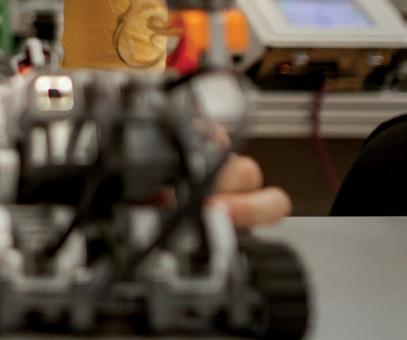

Contact a Dell Technologies Advisor at 877-ASK-DELL or Dell.com/sb THERE’S AN INNOVATOR IN ALL OF US. That’s why Dell Technologies and Intel create technology with innovation built-in, so every person and every business can do more incredible things.
SINCE LAST ISSUE
Since Innovation & Tech Today’s last issue, a lot has transpired. And this comes as no surprise when considering the fast-paced tech industry. Issue 9.1 was all about artificial intelligence (AI). This new tool was and still is transforming business operations by making processes more efficient and effective. We dived deep into various AI applications, such as virtual and augmented reality.
We also had the privilege of interviewing David Costabile in issue 9.1, an actor best known for his roles in TV shows such as Breaking Bad and Billions. He spoke on sustainable and forward-thinking smart home upgrades and the importance of incorporating renewable energy. Billions’ 7th season premiered after our last issue and has been a huge success!

The main focus of issue 9.2 is electric vehicles and connected cars. With concerns about climate change at an all-time high, it was essential to shed some light on how tech makes sustainable options in the automotive industry possible. The issue explores its infrastructure and predictions of the future. We also cover new pet tech, the metaverse, health tech, entertainment, AI, and the impressive advancements happening in Texas.
Innovation & Tech Today even had the chance to get an inside look into the future of entertainment! After hearing about the iconic Sphere in Las Vegas and the abundance of tech being utilized, we had to explore how it would be revolutionary. We examine the unique innovations at the Sphere, such as the LED exosphere, the beamforming audio system, and more.
The Irish rock band U2 was the first to experience the new era of meshing exceptional tech and music with fans at the Sphere. We had the incredible opportunity to speak exclusively with U2’s lead guitarist, keyboardist, and backing vocalist, The Edge, before the band’s debut at the Sphere. The Edge talks about finding the venue and how the show is unique thanks to the rich incorporation of tech. Additionally, the feature story has insight from Willie Williams, the creative director for U2. Williams, among many other visionary masterminds, uses tools such as artificial intelligence and virtual reality to make the art come to life during the performances.

#innotechtoday
For print or digital subscriptions, visit innotechtoday.com, or find us on popular digital newsstands and readers.

Amir Sachs
Ashley Pearce
Ashray Malhotra
Vishwanath Hegadekatte
Shravan Kumar Reddy Poli
Kevin Kohl
Rahul Mittal
4 INNOVATION & TECH TODAY | VOL. 9 / ISSUE 2
innotechtoday innotechtoday innotechtoday innotechtodaymagazine
INNOVATION & TECH TODAY – Vol. 9 / Issue 2. Innovation & Tech Today is published for $19.95 per year. POSTMASTER: Send address changes to INNOVATION & TECH TODAY, 1750 Wewatta Street, #1821, Denver CO 80202 PUBLISHER/EDITOR-IN-CHIEF Charles
DIRECTOR
Warner cwarner@goipw.com CREATIVE
Shane Brisson shane@goipw.com MANAGING EDITOR Lindsey Feth ASSOCIATE EDITORS Jeremy Glowacki Patricia Miller CONTRIBUTING WRITERS Thomas Hainzel
SENIOR ACCOUNT EXECUTIVES
VIDEO/PODCAST PRODUCER
Printing Journal Graphics Published by: INNOVATIVE PROPERTIES WORLDWIDE, INC 1750 Wewatta Street, #1821, Denver CO 80202 | (720) 476-4920 www.innotechtoday.com | info@innotechtoday.com To learn more about unique advertising opportunities, please contact us at 720-476-4920. All trademarks, service marks, photos, and logos contained within this publication are the property of their respective owners, and may not be individually identified in this publication.
Gretchen Philyaw TETL CHIEF REVENUE OFFICER Jessica Ferranti
Steven Higgins
Alan Tuszynski Distribution CMG
This publication is dedicated to the dreamers, the innovators, the collaborators, and the doers – who can’t be
by
it
be
is
bothered
those saying
can’t
done. Nicholas and Aria, the future
yours! SPECIAL THANKS TO: Brian T. Boothe, Rita Tennyson, Gary Shapiro, Netflix, Full Coverage Communications, Sphere Entertainment Co.







contents 60 Feature Story U2’s Performance at LV Sphere Showcases the Power of Innovation By Charles Warner and Lindsey Feth Photos: U2 | SamJones Sphere | Sphere Entertainment Compositing | Shane P. Brisson Departments 8 Event WrapUps 10 By the Numbers 12 Quickbytes 16 Topical Tech 20 Pet & Family Tech 22 Metaverse 72 Product Revolution 78 Events/Coming Next Issue 80 The Lighter Side 24 Innovator Profile An Exclusive Interview with Dr. Tarika Barrett, CEO of Girls Who Code By Lindsey Feth 26 Outdoor+Adventure Tech Electric-Powered Adventures: A Look Into the Zero Emission Winnebago eRV2 30 The Best of CES A Recap of the Year’s Famous Tech Extravaganza 34 Health Tech How to Protect Your Medical Data 36 How VR Technology is Changing the Pediatric Experience 38 How Mindfulness and the Calm App Promote Productivity 40 Gaming+Entertainment Oren Soffer and Gareth Edwards’ Dramatic Vision of AI Comes to Life in The Creator 42 Actors Reaching Stardom With AI 44 Artificial Intelligence Using AI Tools in R & D to Leverage Data 46 Advancements and Challenges of AI in Self-Driving Cars 48 Connected Car The Evolution of Electric Vehicle Infrastructure 50 Remarkable Advancements in LightYear Solar-Powered Cars 52 Navigating the World of Electric Vehicle Charging 54 Regional Spotlight Why Austin is the New Tech Hub 58 Women in the Lone Star State 59 Tech is Bigger in Texas — By the Numbers 66 Sustainability Today An Exclusive Interview With Wildlife Filmmaker Bertie Gregory 26 38 6 INNOVATION & TECH TODAY | VOL. 9 / ISSUE 2 54 75 68 STEM Today Balancing Benefits, Concerns, and Ethical Use 75 Top 50 Most Innovative Products

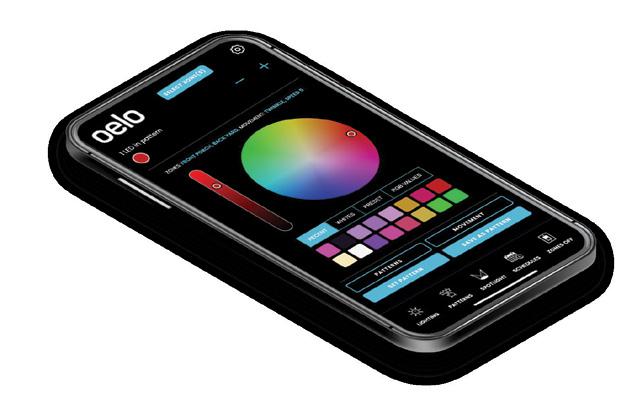
Stop fussing with your holiday lights. Start celebrating EVERY occasion.
Never hang holiday lights again thanks to Oelo Permanent Holiday Lights! Practically invisible by day, our permanent holiday lights blend in with your fascia for a seamless look, while these color-changing lights are uniquely expressive by night thanks to the customizable color app. Install them once and let them light up your day-to-day moments, celebrations and seasonsfor years to come!
REQUEST A FREE QUOTE AT OELO.COM





• Only "hybrid" out-and-down capable system

• Six controllable zones from 1 controller!
• Twice the LED lifespan of any competitor
• UL-certified, IP68 waterproof-rated lights WHY INVEST IN OELO?

NEW YEARS EASTER FOURTH OF JULY HALLOWEEN AND OF COURSE, CHRISTMAS!
ACRYLIC OR METAL CHANNEL
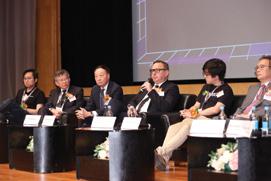
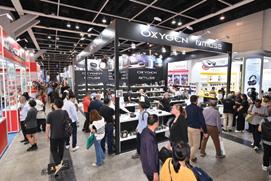
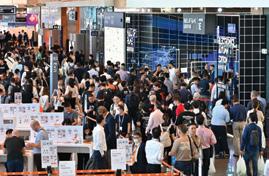
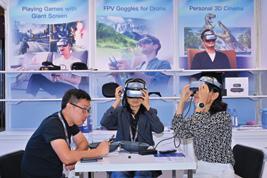


The Hong Kong Electronics Fair (Autumn Edition) and electronicAsia:
The Hong Kong Electronics Fair (Autumn Edition) and electronicAsia physical exhibitions took place in Hong Kong on Oct. 13-16. Organized by the Hong Kong Trade Development Council (HKTDC) and MMI Asia Pte Ltd, these two four-day events gathered over 60,000 industry buyers from 146 countries and regions participating in person. These exhibitions served as a hub for global buyers, showcasing the latest tech advancements. The event presented cutting-edge innovations, including wireless charging, network technology, artificial intelligence, and robotics.


2023 Green Sports Alliance Summit:

The 2023 Green Sports Alliance Summit was at the Climate Pledge Arena from June 26-28. This year’s gathering, organized in collaboration with Oak View Group, brought together international partners, industry leaders, and passionate advocates committed to driving positive environmental and social change in the sports and entertainment sectors. The event showcased a remarkable lineup of partners, sponsors, and exhibitors. As the leading global event for discovering innovative solutions, exchanging best practices, and fostering collaboration toward a sustainable future, it aims to inspire and empower attendees to take bold steps within their organizations.



Net Zero Conference:



The 10th annual Net Zero Conference was hosted on Sept. 13-14, welcoming over 1,000 sustainability professionals to the Los Angeles area for climate learning opportunities. The event featured groundbreaking content on ESG, green building, resilience, health and wellness, sustainable materials, personal care, and fashion, presented by international experts. At the Trailblazer Awards Gala, which closed out the conference, Wawa Gatheru, founder and executive director of Black Girl Environmentalist, spoke about her work empowering black girls, women, and non-binary people across the climate movement. Photos: Net Zero Conference/Ling Lou


Dent 2023 Conference:
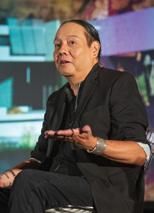

What did you miss at the Dent 2023 Conference? Curious, adventurous, and diverse professionals (like you) gathering to explore and discover new insights. In Santa Fe, New Mexico, a group gathered to talk with and learn from inspirational speakers on subjects ranging from the future of AI, being a daring leader, how hits for major pop stars get made, indigenous futurism, how the poetry of photography can inform our every day, and so much more. Come join this and other events year-round. Visit dentthefuture.com.
8 INNOVATION & TECH TODAY | VOL. 9 / ISSUE 2 DEPARTMENTS / Event Wrap-Ups


The entertainment industry is making new headways with Sphere’s introduction. The recent addition to the city is the epitome of great tech and advanced architecture. Its sheer size and alluring look have made it a trending subject across various social media platforms in the past months.
The legendary Irish rock band U2 debuted on Sphere's stage, which is much more than a concert venue. The location brings together tech, art, and music to give audience members once-in-a-lifetime experiences they’ll remember forever.
When looking at the statistics, it’s easy to get an idea of how grand the extravaganza is and how it’s redefining future expectations for showbiz.
Compiled By I&T Today
366 Ft. Tall 516 Ft. Wide 10 INNOVATION & TECH TODAY | VOL. 9 / ISSUE 2 5.7 Million Cubic Feet In Main Atrium Tickets For U2 Begin at $140 20,000 Capacity With Standing Room 580,000SQ.FT. FULLY PROGRAMMABLE LED EXTERIOR 23 VIP Suites 10,000 Immersive Seats With Infrasound Haptic System 4 Years THE LARGEST SPHERICAL STRUCTURE IN THE WORLD 16Kx16K Resolution Display HYPER CONNECTIVITY For Every Guest Delivering More Than For Every Guest Delivering More Than25 Mbps 25 Mbps Exosphere Displays 256M Colors On Las Vegas Skyline Exosphere Displays 256M Colors On Las Vegas Skyline All statistics courtesy of Sphere Entertainment Co., except where noted. Photo courtesy of Sphere Entertainment. Source: Grammys Source: U2 WINS WINS 22 Grammy 22 Grammy 46 TOTAL NOMINATIONS 46 TOTAL NOMINATIONS U2 HAS U2 HAS U2 Will play 36 Two-Hour Concerts at Sphere U2 Will play 36 Two-Hour Concerts at Sphere Sphere Is U2s First Concert Tour In Sphere Is U2s First Concert Tour In


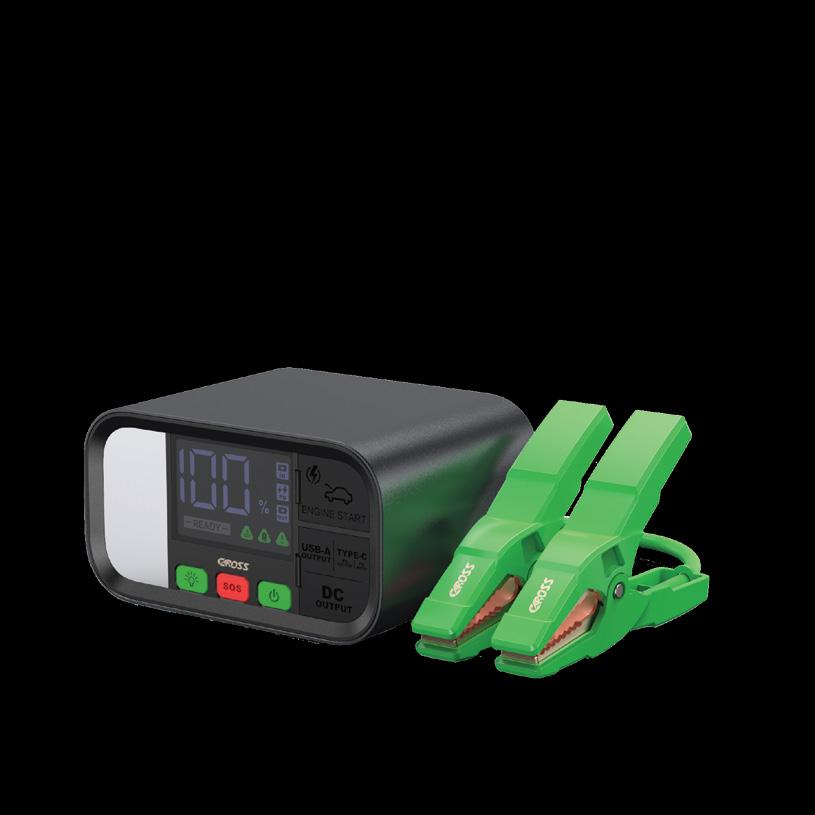





Honda Plans to Focus On Hybrid Models
On Jan. 18, Honda Motor announced its continued focus on the sales of hybrid models and light trucks in the United States in 2024, aligning with increased demand for these vehicle types.
Mamadou Diallo, Senior Vice President of Sales at American Honda, stated, “In 2023, we were

finally able to meet the pent-up demand for our products.” The company anticipates a year-onyear surge in full-year sales in the United States ranging between 10% and 15%.
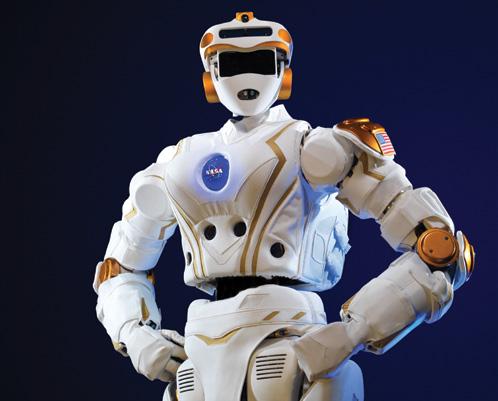
NASA Humanoid Robot Shows Promising Future for Space Exploration
At 6 feet 2 inches tall and weighing 300 pounds, Valkyrie, NASA’s humanoid robot, is currently being tested at the Johnson Space Center in Houston, Texas. Designed to operate in challenging environments, such as natural disasters, Valkyrie, named after a figure in Norse mythology, may soon find purpose beyond Earth.
NASA’s Dexterous Robotics Team Leader, Shaun Azimi, envisions humanoid robots in space undertaking hazardous tasks such as cleaning solar panels or inspecting malfunctioning tech equipment outside spacecraft, allowing astronauts to focus on exploration and discovery.
A group of 11 nonfiction authors, including Pulitzer Prize winners Taylor Branch, Stacy Schiff, and Kai Bird, have joined a lawsuit in a Manhattan federal court, accusing OpenAI and Microsoft of improperly using their books to train models for AI-based software.
The authors argue that the companies violated their copyrights by utilizing their works to train OpenAI’s GPT large language models. The lawsuit filed by writer and Hollywood Reporter editor Julian Sancton includes Microsoft as a defendant alongside OpenAI.
TikTok Invests $1.5 Billion to Expand Online Shopping
TikTok is investing $1.5 billion to become the controlling shareholder of an e-commerce unit within Indonesia’s GoTo. This move will restart TikTok’s online shopping business in Indonesia after regulators suspended online shopping on social media platforms to safeguard smaller tech merchants and user data.

The collaboration between NASA and robotics companies like Apptronik in Austin, Texas, aims to adapt humanoid robots developed for Earthly applications to serve in space missions.

On Jan. 10, Tesla introduced the redesigned version of its Model 3 compact sedan in North America, maintaining its prices, months after the vehicle gained strong demand following its launch in China and Europe.
This move aims to rejuvenate Tesla’s aging vehicle lineup in its largest market. The updated versions of the long-range and rearwheel drive Model 3 variants tech feature enhancements like a rear display for backseat passengers and newly styled wheels.
12 INNOVATION & TECH TODAY | VOL. 9 / ISSUE 2 QUICKBYTES
By I&T Today Staff
Compiled
1 UNITED STATES DISTRICT COURT SOUTHERN DISTRICT OF NEW YORK JONATHAN ALTER, KAI BIRD, TAYLOR BRANCH, RICH COHEN, EUGENE LINDEN, DANIEL OKRENT, JULIAN SANCTON HAMPTON SIDES, STACY SCHIFF, JAMES SHAPIRO, JIA TOLENTINO, and SIMON WINCHESTER on behalf of themselves and all others similarly situated ECF CASE No. 1:23- -10211-SHS FIRST AMENDED CLASS ACTION COMPLAINT JURY TRIAL DEMANDED Plaintiff OPENAI, INC., OPENAI GP, LLC, OPENAI, LLC, OPENAI OPCO LLC OPENAI GLOBAL LLC, OAI CORPORATION LLC, OPENAI HOLDINGS LLC, and MICROSOFT CORPORATION Defendants. Plaintiff Jonathan Alter, Kai Bird, Taylor Branch, Rich Cohen, Eugene Linden, Daniel Okrent, Julian Sancton Hampton Sides, Stacy Schiff, James Shapiro, Jia Tolentino, and Simon Winchester, on behalf of themselves and all other similarly situated (the “Class,” as defined below) for their complaint against Defendants OpenAI, Inc., OpenAI GP LLC, OpenAI, LLC, OpenAI OpCo LLC, OpenAI Global LLC, OAI Corporation, LLC, OpenAI Holdings, LLC, (collectively “OpenAI”) and Microsoft Corporation (all collectively “Defendants”), alleges as follows: NATURE OF THE ACTION 1. OpenAI and Microsoft have built a business valued into the tens of billions of dollars by taking the combined works of humanity without permission. Rather than pay for intellectual property, they pretend as if the laws protecting copyright do not exist. Ye the United States Constitution itself protects the fundamental principle that creators deserve compensation for Case 1:23-cv-10211-SHS Document 26 Filed 12/19/23 Page 1 of 38 Several Authors Join Microsoft Copyright Lawsuit Tesla Introduces Restyled Version of Model 3
Photos courtesy of Honda
NASA
Tesla Photo courtesy of GoTo
Photo courtesy of
Photo courtesy of



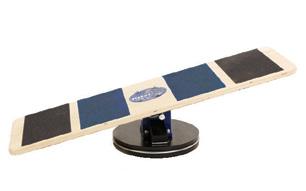

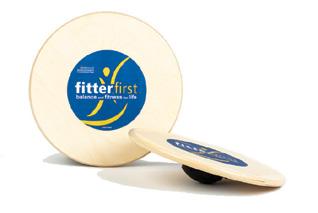







100’s of Quality Products for Home, Office, Club & Clinic Special Offer 15% off code: MOVEMORE Exp 05/29/2024 www.fitter1.com sales@fitter1.com • 1.800.fitter1 Pro Fitter Ski Trainer Master Your Agility & Strength The Classic...it’s still Awesome! DuraBall® Exercise Balls Core Strengthening & Stability World’s Strongest Exercise Ball Chair Balance Boards 16” & 20” Ankle ROM & Injury Prevention Tri-level design to keep you improving Extreme Balance Board Pro Our most Challenging 2-level 3D Board Built to Club Quality Standard MADE IN USA Promote Blood Flow While You Sit! Fit in good health everywhere you sit! Easy Compact Take Anywhere Travel Home Office Move More to Move Better! Unlock Long-Term Health & Vitality Through Movement with Fitterfirst’s Innovative Functional Fitness Tools. Enjoy Enhanced Core Strength, Reduced Injury Risk & Elevated Productivity!

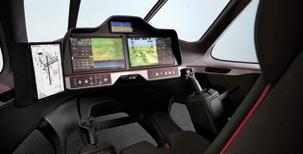
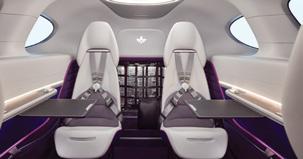

EU Approves Air Taxi Firm
Lilium
German air taxi company Lilium has received regulatory approval from the European Union Aviation Safety Agency (EASA) to design and operate its electric vertical takeoff and landing (eVTOL) vehicles.
The approval, known as “Design Organization Approval,” is a special condition license granted by EASA, allowing Lilium to design and manufacture its aircraft in the absence of formal industry rules. Alastair McIntosh, Lilium’s Chief Technology Officer, stated that this approval is a “license to operate” for the company.

Xbox PC App Gets Microsoft’s Compact Mode
Microsoft has introduced the “compact mode” for the Xbox PC app, improving usability on handheld gaming PCs. According to the Xbox Wire blog post, the update is now available for users after testing. In this mode, the sidebar transitions into icons, optimizing screen space.
Especially beneficial for devices like Asus’ ROG Ally and Lenovo’s Legion Go, Microsoft is collaborating with tech manufacturers, such as Asus, to enable “compact mode” by default on handheld devices. Additionally, the Xbox PC app will streamline notifications, displaying only unread ones in the drop-down, and introduce a “Gaming Services Repair Tool” for troubleshooting.
OpenAI Debuts New Products
OpenAI introduced two new tech offerings to its users: the GPT Store and ChatGPT Team. These developments highlight OpenAI’s determination to quickly advance its product lineup to surpass competitors like Anthropic, Google, and Meta.
Both the ChatGPT Team and the GPT Store will serve as revenue streams for the company. Although they have been in development for some time, the GPT Store had been temporarily delayed until now due to CEO Sam Altman’s brief removal and the subsequent board reshuffling.
Google Introduces New AI Model Gemini
On Dec. 6, the new AI model Gemini was unveiled. The Google parent company, Alphabet, highlighted that the awaited AI system surpasses OpenAI’s latest tech model in speed and can process diverse types of media, including video, audio, and text. Gemini is available in three versions, each tailored to utilize varying levels of processing power.
While Alphabet has long held a prominent position in AI research, OpenAI’s ChatGPT took the spotlight in Nov. 2022, allowing Microsoft (MSFT.O) to introduce AI-powered software for businesses. With the introduction of Gemini, Alphabet hopes to reclaim its prominence in AI.
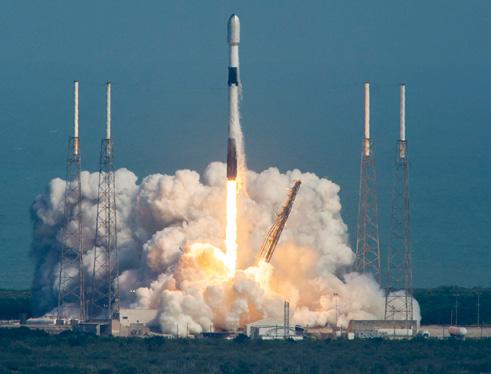
SpaceX Launches Falcon 9 Rocket
On Jan. 2, SpaceX successfully launched a Falcon 9 rocket, carrying the initial batch of Starlink satellites equipped to transmit phone signals directly to smartphones from space.
Per the announcement made in Aug. 2022, T-Mobile will utilize SpaceX’s Starlink satellites, under the ownership of Elon Musk, to deliver network connectivity to mobile users in specific regions of the United States.
Several global wireless providers, including KDDI in Japan, Optus in Australia, One NZ in New Zealand, and Rogers in Canada, will join forces with SpaceX to introduce direct-to-cell tech. Initially, the direct-to-cell service will commence with text messaging, with plans to expand to voice and data capabilities in the coming years.

14 INNOVATION & TECH TODAY | VOL. 9 / ISSUE 2
QUICKBYTES
Photos courtesy of Lilium
Photo courtesy of Space X
Photo courtesy of Microsoft
MaxRanger4K™
Longest, strongest wireless for maximum security
Longest Wi-Fi range yet, up to 2000’ & stronger signal penetrates through walls & obstacles
4K Ultra HD day & night video color from best-in-class Sony STARVIS™ sensors
100% wireless & always charged with built-in solar panels
True Detect AI™ sensors sense heat, motion, people & vehicles to trigger recording & alerts
Always free local recording on internal 64GB MicroSD card
Ideal for urban houses, businesses, farms, large properties & challenging locations
Winner of 4 awards at CES
Available with 2, 3 or 4 cameras & hub AVAILABLE SOON
ActiveResponse™
Personal alarm for safety every step of the way
Pull the ring to activate the loud 110 decibel siren
Push the button to silently notify a personal contact(s) of your GPS location
Subscribe to notify up to 5 personal contacts, professional monitoring & police
Wear around your neck, clip on your bag or keyring, or carry in your pocket
Winner of 3 awards at CES
Available in two cool colors (aqua or graphite)




AVAILABLE NOW
swann.com
The Rise of ChatGPT

The Newfound Power of AI in the Workplace
By Lindsey Feth
With the quick adoption of AI, it’s no surprise that it’s swiftly making its way into the workplace. ChatGPT is an AI tool making major transformations for employers and employees alike. This AI-powered chatbot, which uses natural language processing, can be the missing piece for companies wanting efficient workflow.
In addition to answering basic questions, ChatGPT can generate images and videos, draft emails, give specific instructions for various tasks, hold a conversation, explain code in programming languages, and more. So, what can we expect the future to look like with this new innovative tool that seems too good to be true?
Cisco delivers software-defined networking and security solutions to various businesses with a mission to realize AI’s significance while following standards for transparency, fairness, and accountability. Jeetu Patel, Cisco’s executive vice president and general manager of security
and collaboration, provided a first-hand look into how ChatGPT will change the modern-day workplace as we know it and reshape how we move forward.
The Benefits of ChatGPT
“AI is transforming the way we connect, collaborate, and work, and though we’ve just begun to scratch the surface of all that’s possible with AI, recent advancements in LLM (large language models) are allowing technology to better understand human intent and respond in more human ways,” Patel said. “This means that we will see increased AI integration in the workplace as the technology can improve employee productivity and efficiency by assisting with tasks that previously required human involvement.”
ChatGPT comes with lots of benefits. After reviewing its capabilities, it’s not hard to imagine how this human-like tool can make life easier and quicker. In addition to increasing
16 INNOVATION & TECH TODAY | VOL. 9 / ISSUE 2 DEPARTMENTS / Topical Tech
Photo: iStockphoto/imaginima










efficiency, ChatGPT can improve the quality of work (especially in a digital setting) with its SEO optimization tools and ability to create new content with accurate grammar.
It’s essential to note the positive adaptability that ChatGPT offers users at every level. Whether it’s a major corporation with thousands or a small business just starting, the AI tool can provide stellar customer service and increase productivity.
The Drawbacks of ChatGPT
There are challenges the AI tool might bring to the table. For example, ChatGPT can reduce the need for creativity. Plus, it’s possible to overuse the tool in a work environment, which decreases collaboration and damages employee relationships.
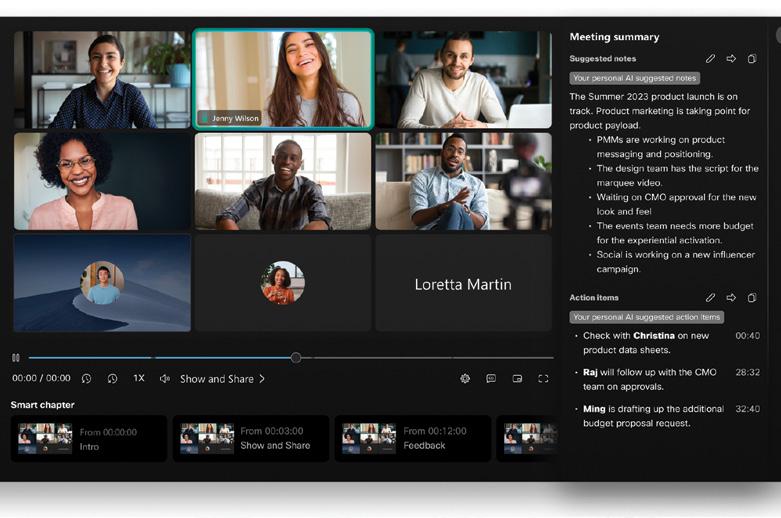
By referencing solely existing data, ChatGPT can’t create fresh new ideas that a human can. The AI tool can’t apply real-world events happening now or think of new ideas based on personal life experiences, which is the intrinsic way humans can connect with their work.
Patel warned that ChatGPT should be used with the right amount of caution: “Despite the tremendous positive impact of AI, it’s more critical than ever that the industry ensures responsible and ethical use cases and guidelines are implemented. Because AI can automatically generate insights that influence critical decisions and actions, it’s imperative to implement clear governance over how we develop, deploy, and operate AI-based solutions.”
With a lack of creativity and contextual awareness, ChatGPT also has the potential to generate content that contains harmful prejudices or biases. Because the AI tool is referencing only the data it’s given access to, it may unintentionally create content based on someone else’s opinions, not facts. If this is an issue, a business can also begin to deal with unnatural tones of voice that can rip away a specific reputation or persona it was aiming for with its consumers.
ChatGPT has some security risks as well. While it can be a transformative step for businesses, it’s essential to recognize the impact of new tech. “If not careful, AI integration can expose company vulnerabilities and yield sophisticated cyber-attacks,” Patel said.
With this language-based AI, ChatGPT opens up many opportunities for hackers to use the tool for phishing scams. In these instances, cybersecurity threats can be much more prevalent since hackers who use AI tools to impersonate others can access valuable information that threatens the company’s and its consumer’s privacy.
Patel urged caution, for the integration of AI can “expose company vulnerabilities and yield sophisticated cyber-attacks.” The tool can do more harm than good without ensuring data privacy and safeguarding information with proper training.
ChatGPT in the Future
ChatGPT is likely to have an innate role in the future of the workplace. The widespread adoption in recent months has businesses seeing the power of this new AI tool and testing the waters for how they want to use it and where they’re drawing the lines with ethical usage.
Patel explained how ChatGPT will embrace the evolving tech world and use modern devices: “In the office, AI can be leveraged for modern video devices that are purpose-built for each workspace and that do things like focus in on individuals in the room, capture the best angle of participants at any moment, or give every participant their frame. This provides a level of inclusivity that ensures everyone in a meeting — no matter where they are joining from — can be seen and heard.”
To see ChatGPT used in the future, it’s important now more than ever to use it in the right way and at the right times. If not, this AI tool might quickly create ethical issues in the workplace and spoil the opportunities it offers for industries and companies of all sizes and locations.
“As the AI landscape continues to evolve, it’ll be paramount for organizations to provide employees with education and training on ways to effectively utilize AI tools,” Patel said. “This means that employees must be equipped with an understanding of how to properly employ this technology and be prepared to navigate known risks like the spread of potentially fabricated information and potential scams.” ■
18 INNOVATION & TECH TODAY | VOL. 9 / ISSUE 2 DEPARTMENTS / Topical Tech / The Rise of ChatGPT

An exciting career is closer than you think. An exciting career is closer than you think.
Invest in your future with only an hour a day
Invest in your future with only an hour a day
Playing Haiku only an hour a day for a week can help you take the first step towards a career in cybersecurity.
You don’t need experience — just the passion and drive to enter a field that opens limitless opportunities around the globe.
Get started with our training path for the Certified in Cybersecurity (CC) Exam from ISC2, the world’s leading cybersecurity professional organization.

haikuinc.io 1000100 00110 011 HAIKU INC.
The Fitbark 2: Pet Wellness at Your Fingertips!
Track Your Best Friend’s Health Like Never Before
By Lindsey Feth
Many of us are constantly tracking our daily steps, sleep quality, calorie intake, heart rate, body temperature, and more, which helps us maintain our health and stay the course of our fitness journeys. Tech such as smart watches or simple tracking apps makes this data available in record time.
With pets being a part of the family for many, it’s just as crucial for owners to track their pet’s health and to see their day-to-day wellness. Pet tech is undergoing a revolution. Consider the Fitbark 2. It tracks your pet’s location, updates continuously, and offers weeks of battery life. Plus, it easily connects to nearby networks so you don’t lose connection with your pet. It’s changing how owners approach their pet’s health by offering real-time movement tracking right at your fingertips.
The Fitbark 2 specifically helps owners track dog health and gives an overview of how the data from the pet wearing the device differs from other canines of the same (or different) breed. Weighing only 16 grams and waterproof, the Fitbark 2 is suitable for dogs as little as five pounds to as big as 240 pounds. In addition to dogs, the Fitbark 2 works great for other common pets, such as cats and rabbits, and even for exotic animals, such as penguins, zebras, and more!
With minute-by-minute movement tracking and the total calories burned documented, the activity index on Fitbark 2’s app is based on meticulous data. In addition to seeing activity patterns, the device can uncover sleep tendencies and details about sleep quality. The app connected to the FitBark 2 can give owners a clear idea of their rest with a daily sleep score.
Once the device gets information about sleep
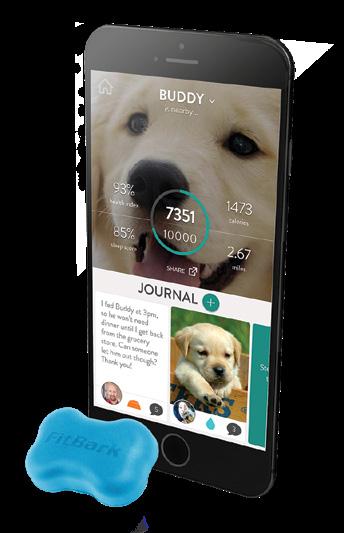
and daily physical activity, the Fitbark 2 can also reveal what this data means and uncover potential medical conditions such as mobility, anxiety, and skin issues.
With Fitbark consulting over 45 research institutions, the device can discover information on how the pet’s weight and age impact their daily activity, trends that correlate to the breed, histograms of activity percentiles, and their activity’s correlation to osteoarthritis, cancer, and heart disease.
What’s even more innovative and makes health tracking even greater is Fitbark 2’s link features. Once investing in the Fitbark 2, pet owners can link their health and wellness stats

with their pets on Fitbit, Apple Watch, Google Fit, and HealthKit for a united health chart to help improve fitness journeys together.
Showing pet health information to others is straightforward. The app transmits wellness information quickly and easily to pet sitters or veterinarians.
Getting started with FitBark 2 is quick and easy. To begin, pet owners choose one of the ten colors available and attach the Fitbark 2 device to the collar. Next, installing the FitBark mobile app and selecting a plan will get the pet owner on track to getting important information about the pet’s wellness. ■
20 INNOVATION & TECH TODAY | VOL. 9 / ISSUE 2 DEPARTMENTS / Pet & Family Tech
Fitbark 2 showing home screen and GPS data (right).








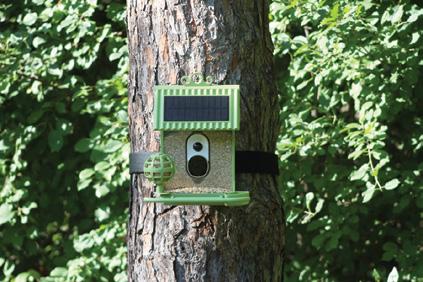






Industrial Metaverse
How Business Value is Driving Adoption
By Thomas Hainzel, Head of Digital Industries Evolution and Partnerships for Nokia
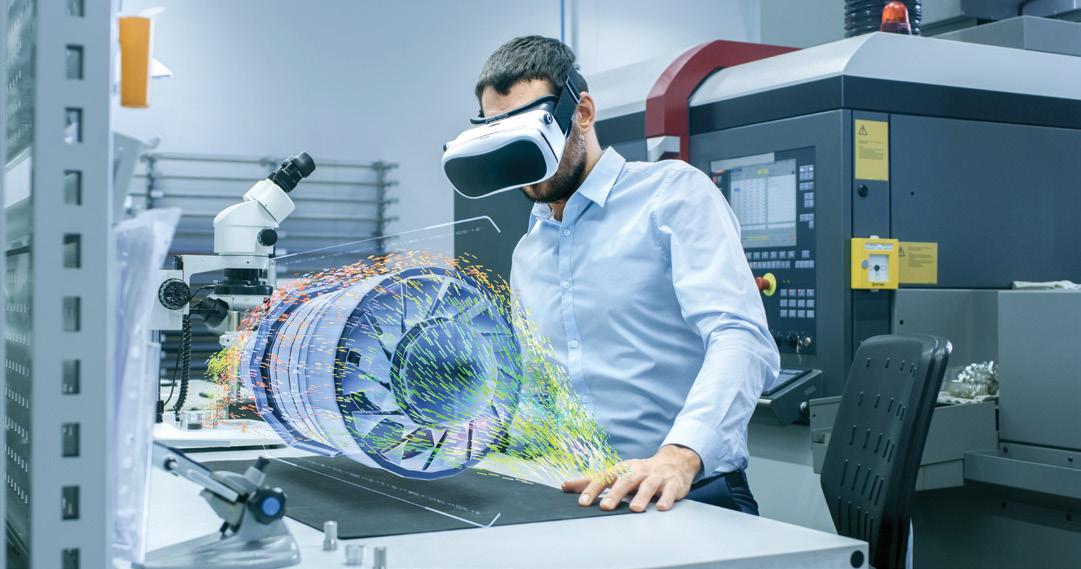
The idea of an immersive virtual reality where humans interact as avatars in a simulated environment may seem a little out there for most people. Yet today, the benefits of the industrial metaverse — where the physical and the digital come together, boosted by the power of artificial intelligence (AI), machine learning (ML), high-performance networks, the cloud, virtual/augmented and extended reality (VR, AR and ER), and 5G/6G connectivity — are beginning to solidify.
And it’s the business value of the use cases that’s making the difference.
Indeed, the recent research with EY shows that businesses are starting to embrace the potential of this augmented world. Eightypercent of experienced respondents indicated they believe that the industrial metaverse will
have a significant or transformative impact on their business. And those companies who have already deployed use cases report more benefits than those in the planning phase say they expect to experience.
The digital twin is emerging as a flagship application of the industrial metaverse. It’s a digital representation of a physical system or environment. It contains physical and procedural properties and conditions and can integrate real-time data and simulations.
3D and PLM market leader Dassault Systèmes refers to this as “virtual twin experiences.” In one of their recent showcases for equipment manufacturers, visitors entered a giant hall, strapped on a pair of smart goggles and a backpack loaded with PCs, batteries, sensors, and actors.
With this equipment, they experienced the virtual world in real-time by immersing in a 360-degree, 3D model of a shop floor containing real-time production and equipment performance data. Visitors could experiment and understand how a virtual platform can improve the simulation and decision-making process and reduce the costs of ineffective operations.
Turns out, this is the kind of application industries are craving.
They can work with real-world data sets and testing algorithms on a virtual testbed. Use cases like schedule and capacity planning, onboarding new team members, and visualizing predictive maintenance make virtual R&D one of the most cited value-creating use cases for the industrial metaverse.
22 INNOVATION & TECH TODAY | VOL. 9 / ISSUE 2 DEPARTMENTS / Metaverse
Photo: iStockphoto/gorodenkoff

By offering visualization, data interoperability, and interwoven digital-physical worlds, teams can engage in prototyping and testing, facility planning and optimization, supply chain, grid or network planning and optimization, and predictive maintenance. All of which can save time, money, and effort while ensuring staff and the environment are protected.
What’s Driving the Metaverse
So, why now? COVID-19 proved a clear inflection point, a disruptor that forced remarkable changes in how we work. Combine that with inflation, supply chain issues, skill shortages, safety requirements, and climate change.
That’s why business value is the clear driver for industrial metaverse adoption.
The concept of virtual reality harkens back a century. By 1968, Ivan Sutherland and his student Bob Sproull had unleashed a VR/AR head-mounted display so heavy it was nicknamed “Sword of Damocles.” Such a forbidding moniker must have given researchers
pause. Since then, there’s been much adjusting and refocusing. Enough that now, use cases are emerging with real heft and business viability. Fifty-eight percent of respondents in the EY survey have already piloted or deployed a metaverse use case.
Imagine a railway operator’s face lit by the thousand tiny dots traversing a 360-degree visualization of the nation’s railway system on a wall of screens before him. Some dots are trains departing stations as frequently as every three minutes and traveling up to 400 kilometers an hour. Others provide signaling data, while still more are alarms blinking between red, yellow, and green to indicate performance metrics or areas of concern.
It’s the peak of summer tourist travel, the capital city is hosting the Olympic games, and the entire nation is in the grips of torrential rainfall. As the operator adjusts routes for the time it takes a train to brake — up to three kilometers in normal conditions, another kilometer on a wet track — a cargo train
derails, and the entire system is immediately in the red zone.
Not the best time for an equipment switchover, but that’s why they’re trialing it — right here in the VR training room. Conjure the worst, and the operator and his team of engineers can simulate it using a digital twin of the nation’s railway network.
A virtual testbed for a mission-critical industry like railways — where there is zero tolerance for error — means they can prepare for the worst of the unknowns.
Digital twinning also applies in the world of medical research. Envisage a virtual lab, where a digital replica of the human vascular network is displayed on a vast screen, and a team of XR headset-wearing phlebologists are injecting a test antidote into the on-screen subject, compiling data, modifying parameters, and simulating algorithms. With cardiovascular diseases the leading cause of death globally, this research can lead to life-altering breakthroughs.
Extend this into the area of vaccine testing or assessing side effects of new drugs for individual patients, and we can change the face of medicine.
Next Up in the Metaverse
Still, these are early days for metaverse use cases.
For the market to grow to the “$100 billion by 2030” forecast by ABI Research, industries will need a robust network foundation built on multi-access connectivity and high-speed computing functions. Secure, ultra-fast networks with low latency and high reliability will power the industrial metaverse and keep mission-critical applications online. Even the most advanced 5G networks will be tested by the requirements of the metaverse, and the work on 6G is already in full swing.
Regardless of the technology, it’s still humans behind the metaverse. Partnerships will be critical as the integration requires high levels of internal skill and external collaboration to succeed. Look for a partner who brings to the table technology leaders, system integrators, global service providers, and industry specialist partners around the world. That kind of powerful team can help realize the new apps and solutions that will drive true business value. ■
INNOVATION & TECH TODAY | VOL. 9 / ISSUE 2 23 Metaverse / DEPARTMENTS
Photo: iStockphoto/baona

Closing the Gender Gap in Tech
An Exclusive Interview with Dr. Tarika Barrett, CEO of Girls Who Code
The innovation and progress of the tech industry in recent years is beyond impressive.
With this said, there still seem to be major disparities in terms of diversity in the workplace. In light of these issues, it’s essential to have organizations that empower those underrepresented to take up space in the industry and use their voices for good. An esteemed organization making positive changes and providing inspiration is Girls Who Code.
With values such as bravery, sisterhood, and activism, Girls Who Code takes the initiative to close the gender gap in the tech industry with transformative opportunities such as clubs, summer programs, and college and career programs that help jumpstart tech careers for those who don’t have the proper resources. Additionally, Girls Who Code utilizes data-
driven solutions to close the gender gap and achieve equality.
Dr. Tarika Barrett, CEO of Girls Who Code, spoke with Innovation & Tech Today about the importance of gender diversity in tech and how positive transformations can happen moving forward.
Innovation & Tech Today: Can you tell us about the mission and vision of Girls Who Code?
Tarika Barrett: Girls Who Code is an international nonprofit organization working to close the gender gap in technology, and is leading the movement to inspire, educate, and equip students who identify as girls or nonbinary with the computing skills needed to pursue 21st century opportunities. Since launching in 2012, Girls Who Code has reached
By Lindsey Feth
580,000 students through our in-person and virtual programming, and 185,000 of our alumni are college or career-aged.
I&T Today: How do Girls Who Code address and challenge stereotypes?
TB: At Girls Who Code, we always say you can’t be what you can’t see. Girls learn in school and through culture about men like Bill Gates, Mark Zuckerberg, Albert Einstein, and Neil Armstrong — but not about the women pioneers in the field like Katherine Johnson, Ada Lovelace, and Jean Bartik.
We work to address these challenges by ensuring that women and nonbinary individuals in STEM are centered in our curriculum. We want our students to understand that diverse people are foundational to the history of STEM.
24 INNOVATION & TECH TODAY | VOL. 9 / ISSUE 2 Innovator Profile
We also place a significant focus on culture campaigns, informed by our community, that bring our mission to the forefront of the national conversation.
I&T Today: In your opinion, what are some of the factors that continue to contribute to the underrepresentation in tech and STEM fields?
TB: We know that top universities get significant attention from recruiters, but what about community colleges and state schools? I, myself, went to a City University of New York college along with other working-class kids. Young women from historically underrepresented groups make up more than half of our Girls Who Code community.
These young women are clearly motivated and ready to learn but often don’t have the same opportunities. They might work multiple jobs while carrying a full college course load, have to balance homework with caregiving responsibilities, or do not have the same resources in their communities that others have. They are the embodiment of bravery and resilience — qualities that are critical to all companies but are not always reflected in conventional academic credentials that tech firms overwhelmingly rely on. This is selfdefeating.
Last, the punishing work culture in tech, rooted in systemic racism and sexism, often alienates young women and women of color once they get their first job in the tech industry. Half of women in tech roles leave by the age of 35, many of them because they felt their workplace was inhospitable to women. Maybe these offices didn’t have adequate parental leave policies, or women weren’t represented in the ranks of leadership, or there was just a toxic corporate culture.
I&T Today: How can businesses and tech companies create a more inclusive and diverse tech workforce?
TB: There are definitely tangible actions
that companies can take to open the doors to more racially and genderequitable workplaces. But, those actions must also be paired with a thoughtful critique. Why did it take us so long to implement these changes? Why was a particular policy that negatively impacted women and people of color normalized in the first place?
So many traits of a white supremacist work culture — perfectionism, professionalism, power hoarding, and paternalism — have become synonymous with the tech industry. We see every day how this has resulted in a concentration of power in tech leadership, how it fuels a “tech bro” culture, and how it leads to burnout. At Girls Who Code, we try to encourage companies to look deeply at their own practices and interrogate what they might be doing to alienate women and people of color, or what they are doing to prevent them from being hired in the first place.
Every company is different and so there’s no blueprint for this type of process. What we’re really asking is that people keep an open mind — redefining what they see as an appealing hiring candidate, and assessing promotion practices that keep women and women of color out of leadership positions. That kind of self-reflection is difficult, but it can be the difference between an all-white, male office and an office that more accurately reflects the world we are living in today.
I&T Today: Looking ahead, what are your goals for Girls Who Code in the coming years?
TB: We just celebrated our 10th anniversary in 2021 — a huge milestone for our organization. We’ve already served 580,000 students since our founding, and are on track to close the gender gap in entry-level tech jobs by 2030. However, we’re now looking toward a new north-star goal to reach 1 million students in the next 10 years. ■
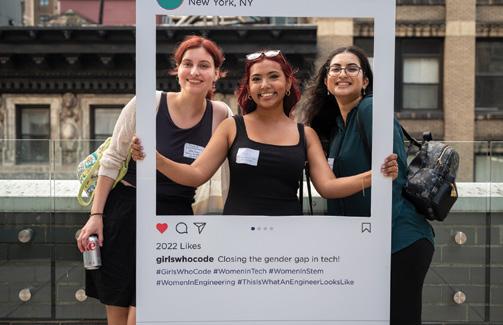
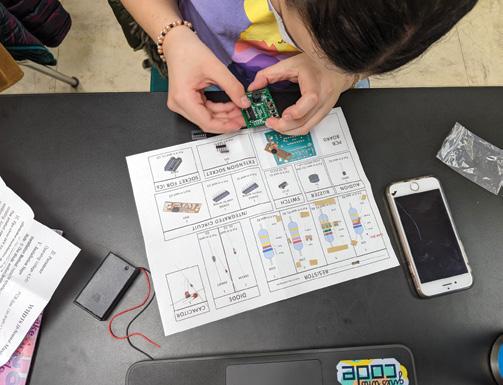
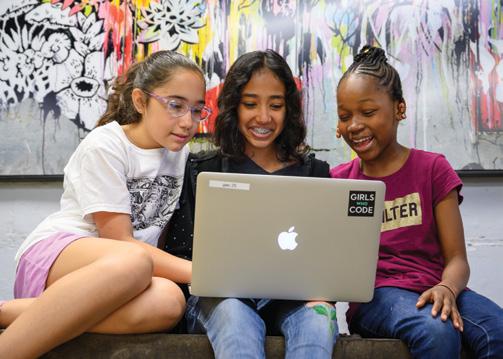

INNOVATION & TECH TODAY | VOL. 9 / ISSUE 2 25
Electric-Powered Adventures
A Look Into the Zero Emission Winnebago eRV2
By Lindsey Feth

Winnebago Industries, Inc. is a prominent American manufacturer of all things outdoor lifestyle, featuring brands such as Winnebago, Grand Design, Chris-Craft, Newmar, and Barletta. The corporation is a top industry competitor and provides products for recreation activities, such as travel trailers, fifth-wheel products, and boats. Specifically, the Winnebago brand is a leading name for motorhomes, and the company is taking steps to do its part for the environment by creating products that decrease carbon footprint with the help of some impressive tech.
In January 2023, Winnebago Industries, Inc. unveiled the eRV2 at the Florida RV SuperShow in Tampa, Florida. The eRV2 originated from Winnebago Industries’ initial concept vehicle, whose introduction was at the same event in
2022. During the 2023 Tampa SuperShow, attendees had the opportunity to test drive the eRV2 on-site and provide feedback directly to the company.
The Recharging Capabilities
The eRV2 is powered entirely by electricity, providing quiet and environmentally conscious travel. Winnebago collaborated with Lithionics Battery to create the IonBlade lithium house battery. The advanced battery is the safest, most concentrated, and compact solution available. The electric power system and home battery allow up to seven days of off-grid adventures without fossil fuels.
The versatile 3-in-1 plug is convenient and allows owners to charge the RV from home, at campgrounds, or at designated charging
stations. House-system charging takes as little as 2 hours, while chassis charging takes 45 minutes.
In addition to the electric charging capabilities, the eRV2 can also utilize solar energy. The 900-watt solar energy system can generate up to 500 watts from fixed roof panels and 400 watts from portable ones. In light of this, the eRV2 can extend your stay even longer without worrying about power outages.
The eRV2 is built on a Ford E-Transit chassis, delivering robust torque and smooth handling. The current generation of this chassis has a published range of 1,081 miles, making it perfect for a pilot program. Currently, Winnebago is exploring options to extend the range in a future commercial version.
26 INNOVATION & TECH TODAY | VOL. 9 / ISSUE 2
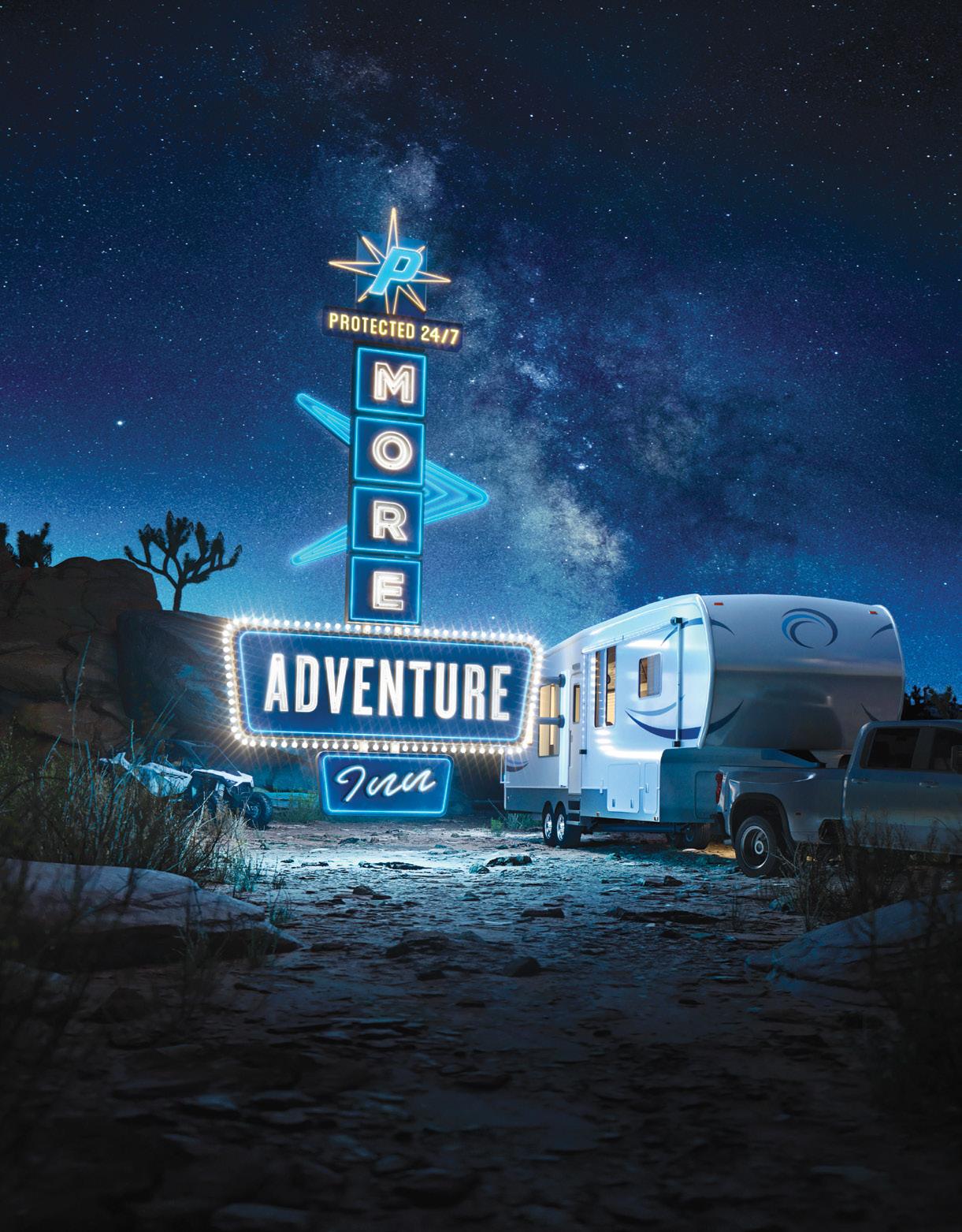

Your RV is all checked in for great protection Get coverage from a leader in RV insurance. 1-800-PROGRESSIVE / PROGRESSIVE.COM Progressive Casualty Insurance Co. & affiliates. Quote in as little as 4 minutes
Electric-Powered Adventures
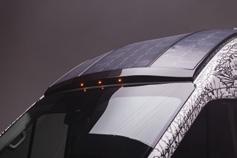


The Interior Design
Thanks to extensive research, user data, and feedback, the eRV2 is supposedly Winnebago’s most human-centric RV yet. The interior is the definition of serene and calm energy. Drawing inspiration from Japandi, a harmonious blend of Japanese and Scandinavian design is perfectly executed in the eRV2.
Every inch of the RV is optimized with built-in multifunctionality to maximize space utility. The living space has a 5-in-1 lounge that transforms into a comfortable sleeping area, dual workstations, and a SmartSpace bathroom.
It includes adaptable workspaces, built-in charge points, and high-speed Wi-Fi for optimal data streaming. The interior also has removable floor mats, the WinnSleep mattress system, and window frame trim.
The Sustainability Features
The eRV2 sustainability features are front and center. The product utilizes lots of recycled materials in its interior.
It features biodegradable materials in its acrylic countertops. The flooring, made by Chilewich, is made in the United States and is engineered with recycled materials. Its bio-felt backing is 100% post-consumer recycled felt and has integrated antimicrobial protection, ensuring its great looks for years.

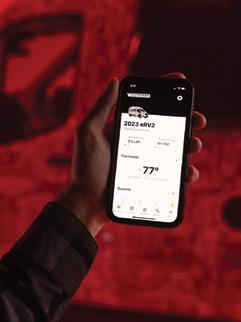
The multi-layer Ultrafabrics Volar Bio cab seat coverings use renewable plant-based materials. Repreve polyester yarn manufactured from recycled water bottles is in the bedroom and lounge seating. Additionally, the unique broadspectrum LED lighting consumes less energy. Users can adjust the interior LED light color across a vast spectrum, including red, supporting the dark-sky initiative, reducing light pollution, and minimizing the impact on local plant and animal life.
The Connected Tech


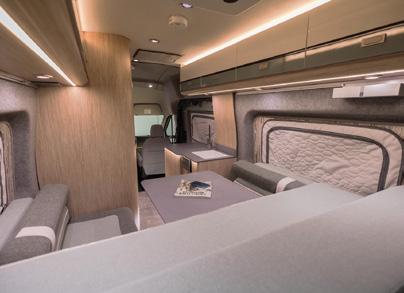
advanced features such as 360-degree cameras, blind-spot assist, and a reverse brake system that detects stationary or moving objects behind the vehicle.
The Winnebago Connect system helps users monitor and control the vehicle’s electrical and energy management systems through an app or a display inside the vehicle. This connected feature ensures real-time information and instant control.
The Winnebago Connect system continuously monitors and adapts house systems to match your preferences while optimizing efficiency. It also provides support tools such as searchable manuals, instructional videos, checklists, and assistance with vehicle servicing, guaranteeing a convenient and user-friendly experience.
Driving the RV is easier than ever, thanks to
Availability of the eRV2
The eRV2 is currently undergoing field testing with everyday consumers to gather valuable insights that will shape its final design before it becomes available at dealerships.
The eRV2 has a pilot statistical overview of more than 25,000 miles tested, 41 testers, and over 200 nights spent camping. Due to the eRV2 still being in a testing period, there is no exact release date to the public or official retail price listed. With this said, many RV enthusiasts have predicted the electric-powered RV to have a value between $150,000 and $200,000. ■
28 INNOVATION & TECH TODAY | VOL. 9 / ISSUE 2
The environmentally friendly Winnebago Connect system, which has a fully electric engine system, keeps a watchful eye on your preferences and optimizes household systems to enhance efficiency automatically with the help of some advanced tech.











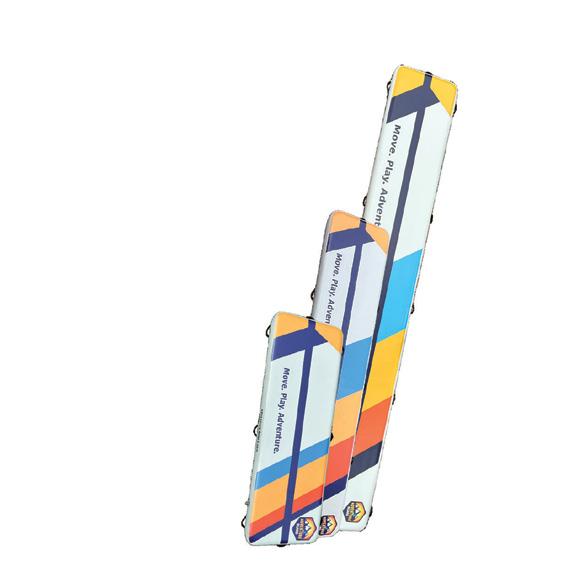
Float | Paddle | Sled | Slide | Rebound | Tumble Slip-n-Slide | Fishing Platform | ...and more Adventure Board™ is a small, family-owned company deeply committed to nurturing sustainable, portable, and creative outdoor play experiences for every age. Unleash Adventure. adventure-board.com One Board. Infinite Possibility.
in three sizes! > > >
A year-round, all-terrain board with adjustable inflatable design for maximum portability and versatility. Eliminate single-use products with Adventure Board, built to last with a Available
The Best of CES 2024
A Recap of the Year’s Famous Tech Extravaganza
By Lindsey Feth
Since the Consumer Electronics Show (CES) debuted in New York City in June 1967, it has continually stood out as the leading global tech event where participants can see groundbreaking technologies and innovators from every corner of the world. Ultimately, it’s the perfect place for brands to conduct business and create new partnerships.
Organized by the Consumer Technology Association (CTA), CES 2024 took place Jan. 9-12, 2024, and was a huge success with 4,000 exhibiting companies present.
“At CES 2024, we’re thrilled to bring together exhibitors, attendees, and media to display and dream up the technology of tomorrow and the innovations that are solving today’s greatest challenges,” said Gary Shapiro, president and CEO of the CTA. “CES is where business and policy converge, and there’s no place like it for building B2B and B2C connections.”
Unsurprisingly, the tech scope of CES 2024 seemed inexhaustible like years before. 3D printing, 5G technologies, AR/VR/XR, artificial intelligence, audio technologies, blockchain, car audio, cybersecurity, digital currency/cryptocurrency, digital health, drones, education, energy/power, entertainment and content, family and lifestyle, and so much more.
While covering CES 2024, Innovation & Tech Today looked at the particular developments of tech in automotive and cars. Additionally, I&T Today witnessed the profound impact of tech events such as CES and how it’s not just a hub for new gadgets but the difference between life and death for some.

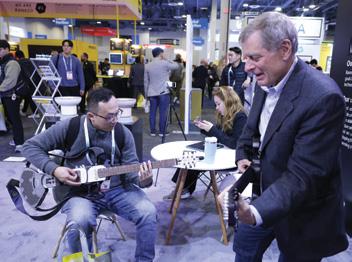

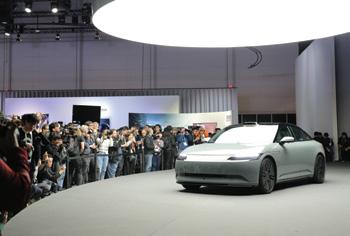



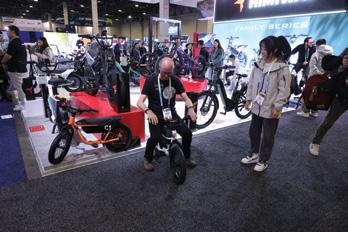
30 INNOVATION & TECH TODAY | VOL. 9 / ISSUE 2
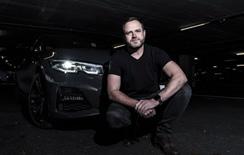


Provizio’s
Provizio, a leading innovator in automotive and mobility safety, unveiled its latest product, VizioPrime 6K, at CES 2024, which provides vehicles with a one-kilometer safety cocoon. This software-defined imaging radar perception solution, designed by Provizio, marks a significant leap in performance.
VizioPrime 6K empowers OEM partners to implement L3+ ADAS and autonomous driving features on a large scale without expensive and intrusive LiDAR sensors.
The groundbreaking innovation of VizioPrime 6K enhances radar capabilities, helping Provizio’s OEM partners to deliver advanced ADAS and AD features costeffectively. With proprietary active antenna technologies, modulation schemes, and sparse array designs, this digital imaging radar differentiates from adjacent objects, such as cars and pedestrians, and performs small object detection, like tires at ultra-long distances. The antenna resolution is vastly expanded at minimal cost, contributing to an improved ability to enhance road safety.
“This advancement is a step
forward, not only for Provizio but the automotive industry as a whole. Historically, some within the automotive industry have been pushing for autonomy before the tech has been safe to do so. Our work at Provizio is reversing this past trend and setting things right with scalable and cost-effective perception. Our belief is that driver safety is paramount, and pioneering innovations centered around this principle will result in impactful transformations in road safety. This goes beyond roads - the technology has already been deployed to make agriculture, industrial machines, and mining safer,” said Barry Lunn, CEO at Provizio
Key technological advancements include Provizio’s patent-protected MIMSO Active Antenna design, leveraging proprietary chip technology to extract 30 times more resolution with 12 times less hardware, resulting in lower costs. The product also features patent-protected SPTDMA multiplexing, enhancing resolution, clarity, and range.
The 5D Perception algorithms and neural nets improve sensor performance, offering radarbased SLAM, object classification and tracking, and free space mapping.
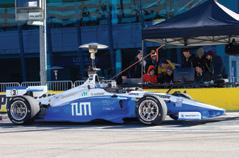
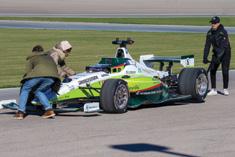

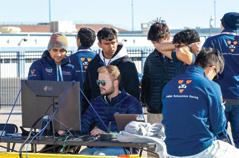
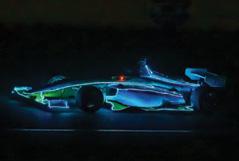
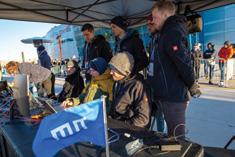
Point One Navigation’s RTK Technology: Safe and HighPerformance Autonomous Racing
Point One Navigation, the provider of high-precision location solutions, was chosen by the Indy Autonomous Challenge (IAC) to supply stateof-the-art Real-Time Kinematic (RTK) corrections technology for the world’s fastest autonomous racing cars at CES 2024.
Point One’s RTK network provides centimeter-accurate location services crucial for boosting high-speed autonomous racing, where IAC race cars often exceed 180 mph. The company’s innovative RTK technology applies to autonomous racing and is available for various autonomous applications, including drones, robots, delivery robots, construction and farm equipment, and autonomous cars and trucks.
“We’re proud to be selected by
the Indy Autonomous Challenge to provide our RTK positioning technology for ALL of the autonomous racing cars at the CES 2024 IAC Racing event,” said Aaron Nathan, CEO of Point One Navigation. “These are the fastest autonomous racing cars in the world, and they highlight the capabilities of our RTK solution and demonstrate our commitment to advancing innovation in the autonomous vehicle industry.”
Point One Navigation’s RTK positioning technology, recognized for its accuracy and ease of integration, received positive feedback from participants in the Indy Autonomous Challenge. Gary Passon, AIracingTech founder, and Autonomous Motorsports Principal at UC Berkeley applauded Point One’s RTK technology for its accuracy, ease of integration, and essential role in optimizing vehicle performance for high-speed competition.
INNOVATION & TECH TODAY | VOL. 9 / ISSUE 2 31
Car
Cutting-Edge Automotive and
Technology
VizioPrime 6K at CES 2024: Paving the Way for Safer and Smarter Vehicles
Innovate or Die: Ukraine’s Tech Resurgence at CES 2024
Inaddition to promoting cutting-edge gadgets, CES 2024 was a great opportunity for visionaries who view technology as a necessity — Ukraine being a prime example. Following Russia’s invasion of Ukraine in February 2022, the phrase “innovate or die” is literal.
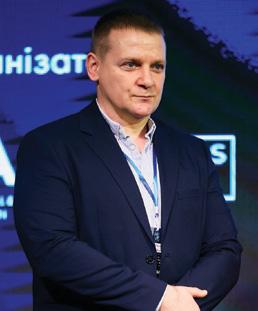

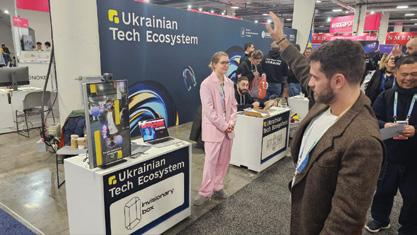
To gain insights into the significance of CES for Ukrainian innovators, I&T Today spoke with Dmytro Kuzmenko, the Chief Executive Officer of the Ukrainian Venture Capital & Private Equity Association, who attended the event.
Before UVCA, Kuzmenko had over
Innovation & Tech Today: What challenges and opportunities do Ukrainian tech startups face globally and how can events like CES help address them?
Dmytro Kuzmenko: One of the key challenges for Ukrainian startups is product-market fit. Thanks to CES, a company can get the first testimonials to use for advertising purposes. In terms of opportunities, real feedback from visitors is more important than any laboratory research from another continent.
Participating in the show also adds credibility to a startup because CES isn’t attended by random people with questionable inventions. A startup team that is present on the floor will find it easier to make face-to-face contact with potential partners, especially in the B2B segment. Have you been doing business with someone thousands of miles away for a long time? It’s a good time to meet in person at a nearby pavilion or restaurant.
In investments and business in general, the issue of trust is always at the top of the list. For the war-torn Ukraine, the situation is even more urgent. That is why it is essential to be visible.
I&T Today: How does the tech community in Ukraine view CES, and what impact does participating in such global events have on the growth and visibility of Ukrainian startups?
Kuzmenko: For Ukrainian startups, CES serves as a gateway to the global
10 years of experience in the investment and finance sphere, including retail lending, investment banking, venture investments, and startup management and acceleration. Kuzmenko has been involved in Ukrainian VC\PE ecosystems, thus gaining deep knowledge of the domestic tech market.
consumer technology market, especially the most desirable one — the U.S. market. It allows a young company to get noticed by the press, to find its first customers, and to be established here. For startups, the USA is like a real El Dorado, with unlimited opportunities for scaling up. Everyone wants to get a famous slice of the American pie. Working in the United States means winning the game called startup.
I&T Today: How has the ongoing conflict in Ukraine influenced the tech industry’s priorities and focus areas in your country?
Kuzmenko: The war has forced startups to rethink their plans, mobilize resources, and focus on higher-priority industries, like defense and military applications. These industries are now experiencing a real boom in innovation, many of which are financially supported by the government (for example, the Brave1 initiative). Specifically, most projects are developing UAVs, electronic warfare, AI & ML, and de-mining. What I think is missing are energy solutions and their decentralization.
One important point to make is that defense and military tech do not mean transferring innovative solutions to the Ukrainian army for free, a kind of charity. Of course, startups develop products for the security of their families and country. But at the same time, they are thinking about selling them to interested parties: both individual allied countries and organizations like NATO.
32 INNOVATION & TECH TODAY | VOL. 9 / ISSUE 2
Startup and commerce are always inextricably linked. And martial law, as strange as it may sound, can be used to the benefit of startups because now any dual-use solution can be tested immediately on the battlefield and get quick feedback from the Ukrainian military.
I&T Today: In what ways has the war in Ukraine prompted a reevaluation of technology needs, especially in critical sectors like healthcare, agriculture, and logistics?
Kuzmenko: In Ukraine, the need for technology has not been denied for a long time (the IT sector accounts for 4.9% of the country’s GDP and continues to grow). On the contrary, more and more hopes are pinned on it in the post-war revival. One often hears comparisons of Ukraine with Israel, and no wonder, because for us, technology means survival.
I cannot say that the war has created a wave of unprecedented technologies. Many, if not most, startups simply found new uses for civilian inventions. For example, in the healthcare industry, it’s bionic prosthetics. They existed before, but they were exotic. Now, startups are aiming to industrially produce tens of thousands of cheap, high-quality prosthetics that ordinary Ukrainians can afford.
The agriculture is focused on mine clearance. In the future, I expect startups to come up with solutions to increase crop yields because the loss of some land will make it necessary to intensify cultivation.
I&T Today: How are Ukrainian tech startups adapting their strategies and solutions to address the unique demands created by the war?
Kuzmenko: The headache for Ukrainian startups today is people. Due to martial law, male employees are not allowed to leave the country and are subject to being called up for military service at any time. This poses a
significant risk because anyone can be drafted, from a humble product manager to a CEO and founder.
When evaluating a startup, investors immediately ask about employees based in Ukraine and also insist that there be a woman among the cofounders. As a result, Ukrainian startups can become leaders in gender balance.
Hardware startups, for which it is not easy to evacuate production facilities, face extra struggles. Facilities can be damaged or destroyed during another missile attack anywhere, so founders are eager to move them abroad.
I&T Today: In what ways are Ukrainian startups contributing to humanitarian efforts through technology, particularly in addressing the needs of displaced populations and refugees?
Kuzmenko: The most common ways startups help their fellow citizens are through free access to their products, conversion of production to meet civilian needs, and direct financial support through various charitable initiatives.
I&T Today: Looking ahead, how do you foresee the ongoing war shaping the trajectory of Ukraine’s tech industry, and what role can international collaborations play in supporting these efforts?
Kuzmenko: I expect that in the future, Ukraine will become a strong player in the defense and military tech industry, which will bring substantial capital in addition to security. In my opinion, the war will further accelerate the development of the innovation sector, as young entrepreneurs will prefer mobile, advanced, and scalable companies.
Be that as it may, I doubt that Ukrainian tech companies will get a head start in the market. Investors are ruthless and remain rational. If that is the case, we are expecting a new generation of great startups because hard times create strong people. ■



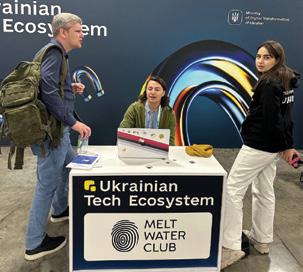
INNOVATION & TECH TODAY | VOL. 9 / ISSUE 2 33
Cybersecurity & Health Information
How to Protect Your Medical Data
By Amir Sachs

We live in an incredible time. Smartwatches monitor our health and apps can track every meal. Technology and health are remarkably interconnected. But the advancements in digital health monitoring come with a major problem — cybersecurity threats.
As we consume and adapt to the latest innovations, we fall short and expose our most personal details — our health data — to potential breaches. So, let’s explore how the latest technology can help avoid that calamity.
Let’s understand why our health data is so sought after and find out what you can do to keep it private and safe.
While the data collected is in the form of zeros and ones, it represents much more. The data tells our personal health story. For doctors, this information is invaluable. It lets them see bigger health trends, which allows them to offer more personalized care to each patient.
For tech companies, this data is a chance to innovate. Think of apps that don’t just record what you eat but also give you tailored advice based on your unique genetics. It’s also a chance for them to monetize you. The more data they hold about you, the better they can target you for their advertisers.
However, this wealth of information can attract cyber criminals. If they get their hands on our data, the consequences could be disastrous, ranging from privacy invasions to financial scams. Aside from the financial damage a
company can sustain, which can put them out of business, the personal ramifications are huge. I recently spoke with some therapists who confirmed that patients have been psychologically devastated by the fact that their personal information has been stolen in a hospital breach.
• Lorraine (not her real name) is considering moving. She was treated at the hospital for a condition kept secret from her tightknit community.
• Michael (not his real name) is a religious leader in his area. His wife is horrified of what will happen if her community finds out about the medical treatment her husband went through recently, which no one outside the immediate family knows of.
• Sara (also not her real name) lives in a religious community and is devastated. She was recently treated for a sexually transmitted disease. If this data is released by the hackers, she will become ineligible for marriage.
When it comes to a hospital breach, or for that matter, any company breach, most of the responsibility and capability to protect the data lies with the institution itself rather than the individual. So, there’s nothing much one can do about it.
Having said that, one indirect way consumers can influence institutions is through collective
pressure and advocacy. If patients collectively demand higher cybersecurity standards and prioritize institutions that demonstrate better data protection, it can encourage hospitals and healthcare providers to invest more in cybersecurity infrastructure and practices.
The crux of the matter is while individuals cannot directly control the cybersecurity practices of large institutions, they can influence change by being conscious consumers and advocating for stricter regulations at a policy level.
We know companies don’t want to spend money on things they don’t consider necessities. In today’s world, cybersecurity in most organizations isn’t prioritized to the extent it should be. With the help of local and federal governments and congresspeople, you as a consumer, can move the needle. It will not happen overnight. It will take time, and we will go through a lot of data breaches until we get there. But as consumers, we need to start this journey.
We live in a data-driven society, and most of us are not aware of the implications on our lives should this data become publicly available. To make our online world safer, we need to understand it better. Even though the details of online safety can feel confusing, they touch many parts of our lives, from shopping to health records. For us, the best defense is knowing more. So, how do we learn more about it?
34 INNOVATION & TECH TODAY | VOL. 9 / ISSUE 2 Health Tech
Photos: iStockphoto

Stay Updated With News
Not all of us are interested in tech news, specifically data breaches in other parts of the country or the world. Here’s an example: Why we should care about a virus outbreak in China? It’s so far away from us, right? Keeping up with the latest technologies and news will not only make you a more interesting person to talk with but it will keep you at the forefront of technology and its implications on our day-to-day lives.

Online Courses
Platforms such as Coursera host beginner-friendly courses on cybersecurity. The aim isn’t expertise but informed awareness.


Community Workshops
Many local institutions provide free workshops on the digital landscape. It’s a hands-on way to grasp cybersecurity basics and its wider implications. Don’t have one in your community? It’s a great idea to start one. Speak with some of the local IT and cybersecurity companies to start a monthly meetup/training on cybersecurity.

Tech Talks and Webinars
We live in a time that offers an abundance of virtual events. Listening to industry professionals can provide a clearer picture of the cybersecurity world.

Knowledge Isn’t Just Power
Educational Advocacy
Push for cybersecurity discussions
in schools. A foundation laid early fosters a future generation that’s both tech-savvy and securityconscious.
In cyberspace, knowledge is mostly protection and security. By educating ourselves, we’re better positioned to demand the digital safety we deserve and bring about a new direction in how organizations view and invest in cybersecurity. ■
About Amir Sachs, Founder and CEO of Blue Light IT (Boca Raton, FL): Amir Sach is a renowned cybersecurity expert providing invaluable advice to small and medium-sized companies worldwide. Sachs has over 25 years of experience in mitigating cyber threats. Sachs founded Blue Light IT in 2003.
INNOVATION & TECH TODAY | VOL. 9 / ISSUE 2 35
Tech
Health
Looking Beyond Medicine
How VR Technology is Changing the Pediatric Experience
By Lindsey Feth
The advancements in virtual reality continue to transform many industries — especially the medical industry. VR is changing the patient experience and making it easier for doctors to perform needle procedures with less pain and anxiety. To get an inside look at VR and its influence on the industry, Innovation & Tech Today spoke with Evelyn Chan, a Rhodes Scholar, pediatrician, and CEO of Smileyscope. She conducted the world’s largest medical VR study and found a way to reduce needleprocedure pain by 60% and anxiety by 40% through the use of medical virtual reality devices. Thus far, she has partnered with over 40 U.S. hospitals to implement the technology.
Innovation & Tech Today: Can you share the story of what inspired you to combine your background in pediatrics with virtual reality technology to address pain and anxiety during needle procedures?
Evelyn Chan: I became a pediatrician to make a positive difference in children’s lives. Having poked thousands of needles into children, I can tell you that the practice of medicine is often traumatic for children, families, and healthcare providers alike. In pediatric residency we were taught to “listen through the cries” — but it doesn’t have to be that way.
I was frustrated by the lack of options to help children with their biggest healthcare fear: needles. To address this, I led a group that conducted world-leading research on the use of virtual reality in medicine. First, we reviewed the scientific literature, finding that VR held promise as a therapeutic tool, but that there were serious shortcomings with existing products when it came to medical use. So, we started Smileyscope and developed a medicalgrade headset from the ground up. We then

created a patented VR program that synchronizes the patient’s virtual experience with the medical procedure — we call this “Procedural Choreography.” We partnered with talented producers to create a world-class animated underwater adventure where waves gently wash over the child’s arm as the nurse sanitizes the injection site, and friendly fish playfully nibble at their arm while the needle is inserted. It teaches patients positive coping skills, allowing both the patient and the clinician to have a better treatment experience.
Poor needle experiences in childhood mean that up to 25% of adults avoid medical care where needles are involved. By intervening early, we can reduce needle phobia and improve longterm healthcare outcomes.
I&T Today: Can you explain how this technology works and its impact on patients?
EC: In early 2022, Smileyscope received patent approval for our core “procedural choreography” technology. Procedural choreography works by synchronizing common medical procedures to a VR scenario; it essentially replaces a negative real-world stimulus, like a needle jab, with a more positive
virtual experience, like friendly fish nibbles. We conducted the world’s largest randomized clinical trial which showed that by reframing these experiences, patients see a 60% reduction in pain and a 40% reduction in anxiety compared to the current standard of care (Chan et al, The J Peds 2019). The study also demonstrated that Smileyscope halves the use of physical restraints (i.e. pinning a child down), and reduces parental distress by 75%.
We’ve since expanded beyond needle procedures and are now seeing Smileyscope being used by clinicians across the hospital for a huge range of medical procedures. They use Smileyscope for wound dressing changes, anesthesia induction, behavioral health, laceration repairs (stitches), and even plaster cast applications/removals. The sky is really the limit.
I&T Today: Could you walk us through the key findings and results of the world’s largest medical VR study you conducted? What were the most surprising or impactful outcomes?
EC: The study we conducted compared Smileyscope VR to the current standard of care (SOC). The current SOC included topical analgesics, a 2D distraction such as a tablet, and a comfort position, which involves the parent holding the child securely to soothe them during the procedure. We suspected that VR would reduce pain and anxiety, but we were surprised to see such a vast improvement over the current standard of care. Patients reported an average of 60% less pain and 40% less anxiety compared to the standard of care — that’s huge!
We were also pleasantly surprised to see the significant reduction in the use of restraints. Parents often dread needle procedures because
36 INNOVATION & TECH TODAY | VOL. 9 / ISSUE 2 Health Tech
Evelyn Chan
if their child needs to be held down, the experience is traumatic for them as well as their child. We were thrilled to see that Smileyscope could reduce the use of restraints to half the rate without VR.
I&T Today: What future developments do you anticipate in the field of medical VR, and how do you envision Smileyscope’s role in shaping these developments?
EC: Gaming and consumer-focused VR has been around for a long time, but procedural VR is in its infancy! Smileyscope began with needle procedures just a few years ago, and we continue to be inspired by the way healthcare providers have embraced the technology. In response, we have significantly expanded our content library and are now seeing Smileyscope used for over 200 distinct procedures all across the hospital.
We see massive potential for VR as a non-pharmacological alternative for pain and anxiety relief. For example, lately, we’re seeing Smileyscope being used to reduce or eliminate the need for sedation medication for minor procedures across the hospital.
I&T Today: How do you see virtual reality technology evolving in healthcare in the coming years, and what role do you envision Smileyscope playing in that evolution?
EC: We are on the verge of an exciting new era in medicine. In the coming years, we see VR having a massive impact on the way we treat patient pain and anxiety. The convergence of crucial factors is paving the way for mainstream adoption. These factors include the maturation of technology, accessibility, and addressing unmet needs. ■

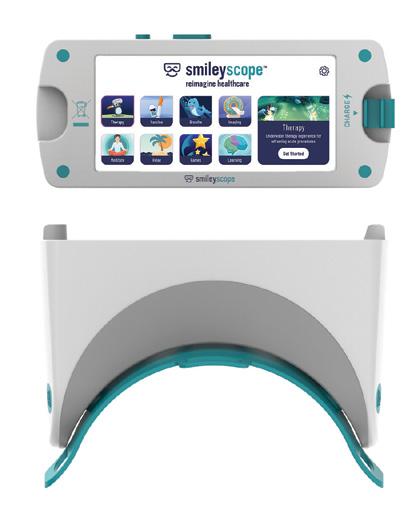
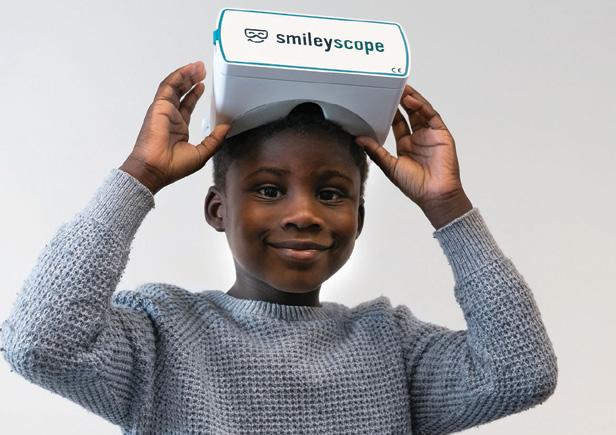
INNOVATION & TECH TODAY | VOL. 9 / ISSUE 2 37 Health Tech
The Importance of Stillness
How Mindfulness and the Calm App Promote Productivity
 By Ashley Pearce & Lindsey Feth
By Ashley Pearce & Lindsey Feth
Making intentional time for stillness has changed my life.
There isn’t a secret way to transcend the human experience or escape pain, as that is part of life. Stillness is a practice many consider a gift. It can be a way to dispel melodrama in daily life by coming back to the present moment and what matters.
It’s rare these days to fully appreciate the world around us outside of our phones and the work demands of hustle culture. I get it. I live in the real world with you and have been discerning how I’d want to present these ideas, as it is ever so important to me that this can feel relatable and accessible.
Stillness can look like pausing that extra two seconds to explore the flavor and aroma of a warm beverage. It can be as simple as taking slow, intentional breaths
during stressful meetings. Stillness can be carving out a thirty-minute window for nature. It can be as radical as turning a phone off while receiving a massage or other activity to immerse yourself more fully into the present moment.
The practice of stillness involves observing, first, how stimulating the world is at times and acknowledging its effects on our lives. The impacts of overstimulation and overexertion, for me, had in the past looked like fatigue, irritability, loss of motivation, resentment, lack of clarity, decreased attention span, and ultimately, burnout.
When pushing ourselves to the max is our standard, what are we compromising in our well-being?
Are we living in a way that invites space for joy, play, laughter, contemplation, and moments of ease?
I invite you to pause for a moment and explore a time in your life when you felt immersed in the experience of some of the qualities listed above. What were you doing at that moment? Can you envision how it felt for you?
If this whole concept feels rough to consider, your feelings are valid. A lot of resistance, guilt, judgment, and other emotions could have come up in the past for you around ways you’ve been taught that your daily life experiences are not as important as your productivity. One way of coming out of this previous belief is remembering that pausing could increase productivity. And then go one step further — is productivity requiring us to rule out brief pauses and breaks? Or are we helping ourselves and giving our brains much-needed changes in stimulation in ways that add value to our productivity? ■

Ready, Set, Be Still.
The Calm App
Calm is one of the top mental wellness apps crafted to help users manage stress, improve sleep quality, and create a healthier lifestyle. Based on extensive research, the app can help users keep habits that support their mental wellbeing. The extensive collection of 250+ Sleep Stories, guided sleep meditations, and calming soundscapes can be a game changer for those who struggle with sleep. Plus, the 60-second Breathe Bubble swiftly grounds users in the present, bringing their bodies to a state of relaxation.
38 INNOVATION & TECH TODAY | VOL. 9 / ISSUE 2 Health Tech
Ashley Pearce is a licensed massage bodyworker and certified yoga instructor
Photo: iStockphoto/peterschreiber.media
WORK
GAME CREATE CHAIRS AND DESKS FOR A UNIQUE WORKSPACE

The Vernazza Supersoft is just ONE of our incredible gaming chairs. Find them all at: www.arozzi.com
Revolutionary Cinematography
Oren Soffer and Gareth Edwards’ Dramatic Vision of AI Comes to Life in The Creator
By Charles Warner
The new sci-fi film, The Creator, premiered on Sept. 29 in theaters nationwide. The film depicts a future world where robots with artificial intelligence rage against the human population in a postapocalyptic war. With themes of AI, its power, and the capacity of human connection, the new movie is a tear-jerker that challenges how humans view new tech and its impact. The deeply immersive and visually stunning film takes storytelling to a whole new level.
Innovation & Tech Today had the pleasure of speaking with Oren Soffer, a director of photography for the new film. Editor-in-Chief Charles Warner chatted with Shoffer about his pivotal role in the creation process, the inspiration drawn from other timeless films such as Star Wars and Alien, the tenderness of human connection and AI, the production process, and how to have the best cinematic experience both at a movie theater and in your very own home.
Innovation & Tech Today: Tell our audience what a director of photography does because it sounds really cool.
Oren Soffer: Well, the director of photography is basically in charge of the camera and the lighting. It’s basically about helping the director translate their vision and create the visual look of the film through the use of camera lensing and lighting.
I&T Today: This was a visually stunning film. Like, I kind of feel like this is something iconic on the level of maybe Avatar. When people say you need to see this on an IMAX, I feel like that applies to this movie. Was that what you guys were trying to do?
OS: Yeah, I think we didn’t necessarily know we were going to get the IMAX release, which has been a really fun bonus. But we were definitely trying to create a cinematic spectacle.
But I did share duties with Greg Fraser, the other cinematographer. Gareth, Greg, and I all grew up sort of loving the same films, you know, Blade Runner, Alien, Star Wars, E.T. — that kind of cinematic spectacle and specifically, science fiction. And a movie that sort of transports you to a different world, different environment, and a different kind of time and place is really what we were always inspired by as filmmakers. I think it’s any filmmaker’s goal and dream to be able to make something that aspires to that same goal of transporting an audience to a different place in a different world and creating imagery and worldbuilding that is immersive, exciting, thrilling, and unique.
I&T Today: Yeah, I think that’s what it felt like for me when I got to see the movie. It didn’t feel like watching a movie. It felt like an experience. It was not like I was just watching a screen, and there
was a beginning and then an end and everything like that. It was immersive, and it felt kind of like I was in that world. Were you going for something like that?
OS: That is actually exactly what we were going for. So it’s very heartwarming to hear. That was our stated goal, and we worked very hard in preproduction and at the planning stage of the film to create the conditions to be able to capture footage that would create a world that felt real, lived in, and immersive.
So it’s the best thing in the world. It’s the best compliment in the world for a filmmaker to hear that a movie didn’t feel like a movie and that it actually transported you.
I&T Today: Yes. At the beginning of the film, it shows pretty quickly what happens to L.A., and then it shows the response of the Senate or some really important people. And I thought it was interesting how you made that grainy, almost reminiscent of some 70s or 80s stuff. So, can you just briefly speak on that because I thought that was a really cool way that you made that all work together.
OS: Yeah. Basically, Gareth Edwards, the director, had a very specific design ethos for this movie that was sort of the hiding principle behind all of these decisions, including those aesthetic decisions that you tapped into.
Gareth’s design ethos for this film is something that is actually inspired by the original Star Wars and George Lucas. The ethos is that if you want to create something that feels truly timeless, you don’t want to have anything in it that is grounded in today’s world, which is something that you see in science fiction — you see imagery and design that is contemporary but futuristic.
So that was the idea behind that, but the larger purpose is to create something hopefully that feels timeless. So, if you watch this movie in 20 years, it wouldn’t necessarily feel like it was made in 2023. It could have been made in 1970, or it could have been made in 2040 when you’re watching it.
I&T Today: So how long did this movie take to film?
OS: We filmed for 90 days. We also had weekends off and then four months of planning and preparation. So the grand total was… more like 9 months of total planning, preproduction, shooting, and everything that’s just planning and shooting. It was then edited, and the visual effects work went on for another year after that.
But this has really been a six or seven-year journey for Gareth Edwards specifically because he really started thinking about this movie right after Rogue One came out, which was 2016. So, this has been a long time in the works.
40 INNOVATION & TECH TODAY | VOL. 9 / ISSUE 2



I&T Today: So was there an effort to, and I don’t want to put words in your mouth or anything like that, but to almost humanize AI?
OS: Yes. We knew that you needed to be able to identify and relate to all of the characters on the screen or AI. Gareth wanted it to actually be very visually clear that the people who are robots are robots and that humans are humans, but definitely did not want to make a distinction in terms of emotion and relatability to an audience between the two.
So, what we actually found very early on was the best way to do that was to not tell anybody that their character was a robot. At least not the background characters. In fact, the more naturalistic and human you act, the more believable the illusion is going to be when you’re turned into a robot because it’ll feel like



the emotion and the humanity is there.
That was always the goal. You know, you don’t want to create a world where you’re asked to sympathize and identify with some blocky robot. It’s very hard to make out emotional connection, and the emotional connection is the core, the heart of the movie.
I&T Today: That was really cool. So let me ask you this: how do you like to watch movies? What’s your preferred setup? You obviously have a tremendous eye, and you appreciate the cinematography, the photography, and everything like that. How do you like to watch movies? What’s your preferred tech setup?
OS: Great question. So I have to separate it between cinema and home as they are two separate environments. There’s a lot of
pessimism about the future of cinematic exhibitions. I don’t share that pessimism. I think there’s never been a better time to go to the movies.
We have great options with so many great theaters, and all of these premium display formats are incredible. So our film is playing in IMAX, Dolby Vision, and in screenX, and these are all just like the highest picture quality and sound quality.
You gotta sit center of the center, in a middle row, a middle seat. Hopefully, the audience is on their best behavior — their watches are on theater mode so the glow goes away, and nobody’s on their phone, nobody’s chit-chatting. You gotta really immerse yourself and focus on the film and be in the dark room.
Now at home, you can’t go wrong with an OLED…I don’t

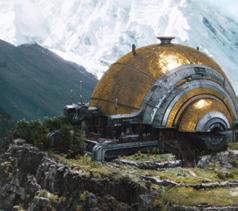
have a surround sound setup, but I do have a nice Sonos sound bar. So that’s my setup, and of course, lights are off, and windows and curtains are shut. If it’s during the day, we have no light pollution filtering in and distracting from what you want that screen to be. That’s the sort of an ideal setup. And both the theater and home certainly benefit from a nice little bowl of popcorn.
I&T Today: Oh, yeah. Gotta have the popcorn. Well, thank you so much. It’s been a pleasure speaking with you. I’m excited to share this with our Innovation & Tech Today audience, and congratulations. It was a really, really amazing movie.
OS: Thanks so much. I’m glad you liked it, and I appreciate it. I hope people will get a chance to check it out! ■
INNOVATION & TECH TODAY | VOL. 9 / ISSUE 2 41
A collection of scene stills from 20th Century Studios The Creator. Images of Gemma Chan as Maya, John David Washington as Joshua, Director of Photography Oren Soffer, and Madeline Voyles as Alphie.
All photos courtesy of 20th Century Studios. All Rights Reserved.
AI in Hollywood
Actors Reaching Stardom With AI
By Ashray Malhotra, Co-Founder and Chief Executive Officer of Rephrase
There was once a time when celebrities were confined exclusively to the big screen. Their charisma, talent, and charm were only savored in movie theaters, a place that allowed the magic of cinema to unfold. The exclusivity of the big screen was seen as paramount even as television gained traction, as the latter was seen as an inferior medium.
However, we’ve seen an exciting shift in this paradigm over the past few decades. Major stars have transcended big screen exclusivity by starring in the golden age of television and eventually opening up real-time and two-way entertainment on social media. Due to the latter, the term “influencer” is no longer a secondary status but a soughtafter career and can even be parlayed into movie-star status. These barriers to traditional stardom have now disintegrated, making way for more accessible and intimate connections between celebrities and their fans.
With that said, the intersection of artificial intelligence (AI) and the world of celebrities prompts a thought-provoking question: Should celebrities use AI techniques to connect better with their audiences?
Improving Engagement and Expediting Media Generation
The idea of using AI to deepen connections between celebrities and fans has gone from science

fiction only a few years ago to nonfiction today. This sentiment was recently shared by Canadian musician and producer Grimes, who sparked a conversation about it on the platform formerly known as Twitter. She proposed that AI could empower artists to expand their reach and scale up their time, a sentiment that I also endorse. By using AI, we can amplify the capabilities of celebrities, enabling them to interact with their fans in previously unimaginable ways.
Producing media with AI’s assistant at this speed and scale isn’t just about fan interactions, it’s about better business. 451 Research forecasts revenue from use cases of generative AI like this will skyrocket from $3.7B in 2023 to $36.4B by 2028. Combine that
with another recent study that shows AI video production alone will grow into a $1.5B market by 2028, and it becomes clear why large media and entertainment conglomerates see the writing on the wall.
Learning New Languages, Aging Backwards, and Forging New Relationships
AI enables unprecedented production speed and a new way for celebrities to deepen their relationships with even more fans by engaging on multiple levels and fostering a more profound understanding of their audience’s desires and expectations. For example, most people, let alone celebrities, can’t speak every language fluently.
However, generative AI has made incredible strides in breaking down language barriers. Even Hollywood directors like Scott Mann are using AI to address these types of issues. Generative AI models can be trained on large multilingual datasets to translate text from one language to another automatically for localizing content. As such, they can handle complex grammatical structures and nuances that might be challenging for traditional rule-based translation systems. From there, the technology can convert spoken language into written text and vice versa, which can then be translated or used for subtitling in different languages making generative AI particularly useful
42 INNOVATION & TECH TODAY | VOL. 9 / ISSUE 2
Brad Pitt in The Curious Case of Benjamin Button | Courtesy of Paramount

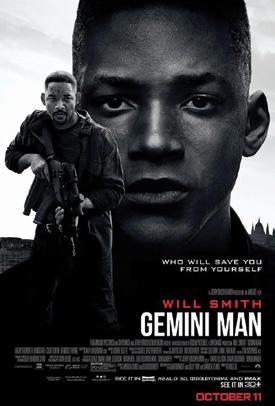
for making content accessible to a global audience.
Even now, celebrities who take advantage of AI-powered duplicates can stay true to their brand and identity while achieving age-defying feats that a human star cannot. One of the most notable examples of this is the de-aging process moviegoers have come to recognize in major Hollywood movies such as Will Smith in Gemini Man, Brad Pitt in The Curious Case of Benjamin Button, and Mark Hamill in Star Wars: The Rise of Skywalker. These
examples make it clear that generative AI is already a part of mainstream culture and illustrate how celebrities of a finite age can broaden the age demographic they appeal to.
Maintaining and Solidifying Artists’ Identity
Of course, the primary concern that arises when we talk about AI in the context of stardom is the preservation of an artist’s identity. It’s become a major stumbling block in the current Hollywood strike as studios and actors negotiate over the ownership of digital avatar likenesses. The concern was also explored in a recent and critically acclaimed episode of Black Mirror, highlighting what could happen when streaming platforms take advantage of celebrities’ identities. But even in the episode, AI wasn’t the villain; the real guilty party was unsavory business practices.
It should be a given that royalties should compensate celebrities for their identities.
The primary goal is not to create content that the celebrity wouldn’t endorse but to provide them with
the tools to amplify their authentic voices and interactions. It’s a monumental opportunity for stars to go multiple levels deeper in their interactions with their audiences.
However, as with any revolutionary shift, the integration of AI into celebrity culture doesn’t come without challenges. There’s a learning curve involved, and studios, celebrities, and their audiences need time to understand and adapt to this new reality. But this initial resistance is reminiscent of the initial pushback against social media. And look where we are now — celebrities across the globe are using social media platforms to connect with their fans daily.
A Modern Partnership Between AI and Celebrities is Forming
When it comes to Hollywooddriven AI techniques, it’s not just about better connections or deeper interactions; it’s about the future of stardom itself. However, the exact impact will depend on how the industry adopts, integrates, and uses these technologies and techniques. Both
actors and writers in Hollywood have some reservations about using AI in their craft. But as we saw with the rise of social media use among celebrities and influencers, AI can also play a similar role in enhancing the stardom of human stars.
Now is the time to embrace the technological evolution of stardom, one AI innovation at a time. Because the future of stardom is rooted in more profound connections, deeper interactions, and a better understanding between celebrities and their fans. It’s a future where stars don’t just influence but also connect, and fans don’t just watch but also interact in real time.
In the evolving landscape of AI and stardom, it’s not just about being a face on the big screen, a voice on a track, or a photo on a magazine cover. It’s about being present, accessible, and authentic. It’s about embracing the possibilities of AI to forge more substantial, more meaningful connections with fans and genuinely revolutionize the future of stardom. ■
INNOVATION & TECH TODAY | VOL. 9 / ISSUE 2 43
Mark Hamill in Star Wars: The Rise of Skywalker | Courtesy of Twentieth Century Fox
Staying Ahead of the Curve
Using AI Tools in Research and Development to Leverage Data
By Dr. Vishwanath Hegadekatte
Over the next ten years, Bloomberg predicts the generative artificial intelligence (AI) market will grow to $1.3 trillion from a market of $40 million in 2022. What’s more, corporations are investing robustly in AI technologies to streamline operations and assist in new innovations — with more than 63% of organizations prioritizing AI over other digital technologies, according to TechCrunch.
So, what do these trends tell us from a corporate efficiency standpoint? The cost of not using AI because of potential risks or privacy concerns outweighs the risk you assume by experimenting with it. Let’s break down what this means, and how companies can strategically navigate a changing landscape in data science.
View AI as a Resource, Not a Threat
It’s no secret there is a lot of hesitancy around AI. Inc. reported many employees fear they will lose their jobs to AI applications. However, contrary to widespread concerns regarding job security, AI actually has the ability to enhance existing jobs, and more importantly, create more jobs in spaces such as data science, machine learning and materials informatics. With the emergence of tools such as ChatGPT, AlphaCode, and more, AI is here to stay, and for good reason — we can use it by integrating it into our workflows for optimization.
Leverage AI and Emerging Technologies to Maximize Efficiency
By 2025, Gartner Insights predicts more than 30% of new drugs and materials will be systematically discovered using generative AI techniques, up from zero today — proof that we’re actively seeing the tool utilization explode
ARTIFICIAL INTELLIGENCE
44 INNOVATION & TECH TODAY | VOL. 9 / ISSUE 2
Photo: iStockphoto
in spaces like manufacturing and product design.
In the research and development landscape, AI — in both traditional and generative models — can assist in developing algorithms that carry out tasks and analysis.
Ask the Right Questions
Before diving in head-first, make sure you’re thinking critically as to how AI can best be a value-add to your company. Tools are costly, and there are a variety of models and applications that require you to make key decisions.
ChatGPT is a relatively cost-effective option for smaller operations looking to test the waters, but there are other AI tools such as PyTorch and Weka for advanced data analytics, and more. So, to be strategic about your approach, do your research and find the right tool that’s the best investment for your needs.
Develop the Internal Know-How; Train and Reassure Your Employees
Internally, it’s extremely important to use AI with care to prevent situations such as data leaks, especially in industries that work with
intellectual property and confidential information. This requires educating your team on best practices.
In addition to the technical aspect, being aware of employees’ collective fears and hesitations toward AI, and getting ahead of them, matters. Informing employees about how the company intends to use AI for efficiency, and not as a replacement, will make for easier integration across the board.
Stay Up-to-Date on New Capabilities and Methods
As a continually evolving sector, and one that promises to continue changing as data and technologies progress, the best way to stay ahead of the curve is to immerse your company
and team in its processes and stay up to date with new machine learning tools and advancements. ■
Vishwanath Hegadekatte, PhD, is the Senior Manager of Future Technologies at Freudenberg North America. With an extensive background developing research and development strategies and implementation methods, Dr. Hegadekatte has played a crucial role in the growth of research staff among many roles throughout his career—in North America, Europe and Asia.
ARTIFICIAL INTELLIGENCE
INNOVATION & TECH TODAY | VOL. 9 / ISSUE 2 45
Revolutionizing Mobility
Advancements and Challenges of AI in Self-Driving Cars
By Shravan Kumar Reddy Poli
Self-driving cars were a dream for ages; they are no longer a dream. Many companies have already launched features of self-driving. Thanks to the integration of AI technology, they are now on the verge of becoming a reality on a large scale. With significant advancements in AI, machine learning, and cutting-edge technology, autonomous cars are on their way to change the world and the way we travel. However, some challenges need to be addressed before self-driving cars become a widely adopted reality able to fully transform our commute.
The key for self-driving cars to be successful and safe is to read and interpret the surroundings. These vehicles heavily rely on advanced sensor technologies such as lidar, radar, and cameras to perceive their surroundings accurately. Lidar enables precise 3D mapping, radar excels in adverse weather conditions, and cameras capture valuable visual information. However, challenges such as occlusions, low visibility, and sensor limitations can impede perception systems. Engineers and researchers are extensively utilizing cutting-edge approaches like simulation-based learning, sensor fusion, and deep learning to enhance the perception capabilities of self-driving cars and overcome obstacles.
Another crucial element in self-driving cars is decision-making algorithms. Algorithms analyze the surrounding environment and make appropriate decisions for vehicles to operate safely. Self-driving cars utilize different approaches like rule-based systems, machine learning models, and reinforcement learning in decision-making. Realtime decision-making entails handling dynamic traffic situations, route planning, lane changing, and merging. Uncertainties, complexities, and ethical considerations pose challenges in achieving optimal decision-making. It is very crucial to maintain the right balance between safety, fairness, and societal values. Continuous research
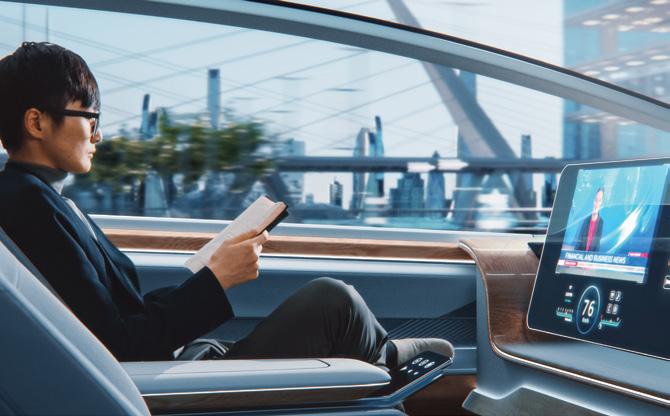
and discussions on ethical frameworks are necessary to address these challenges effectively.
Safety first! A self-driving car’s primary function is to facilitate better road safety. Stringent measures and standards are in place to regulate their development, testing, and deployment. Selfdriving cars need to go through various rigorous safety regulations, testing procedures, and certification standards to ensure safety criteria are met. Risk assessment and mitigation strategies are implemented to enhance safety. However, challenges persist in guaranteeing safety across diverse environments, including urban and rural areas. Self-driving cars require effective communication and coordination with other drivers to avoid accidents.
Ethical considerations form an integral part of the decision-making algorithms in autonomous vehicles. One of the key challenges for self-driving cars is to deal with situations where their decision can have moral implications. A major roadblock is how to determine the balance between safety, fairness, and social values. To address this, it is
crucial to incorporate ethical guidelines, transparency, and accountability into the decisionmaking process. Ongoing research, discussions, and consideration of public opinions and legal frameworks are crucial in navigating these ethical challenges successfully.
The integration of AI in self-driving cars has propelled us towards remarkable advancements. However, challenges in areas of perception, decision-making, safety, and ethical considerations still need to be addressed. By leveraging advanced technology, it is very likely we will experience a new revolution in transportation. This will make driving fun and easy, and most importantly, safer. ■
Shravan Kumar Reddy Poli is the quality manager at ZF Group, a leading automotive supplier. With a master’s degree in industrial engineering and certification as a Program Management Professional, Poli brings extensive knowledge and expertise to his role. His dedication to excellence has made him highly respected in the automotive industry.
46 INNOVATION & TECH TODAY | VOL. 9 / ISSUE 2 ARTIFICIAL INTELLIGENCE
Photo: iStockphoto/gorodenkoff

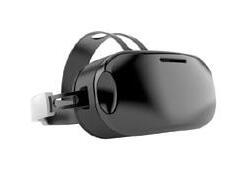

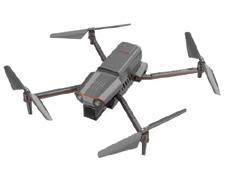
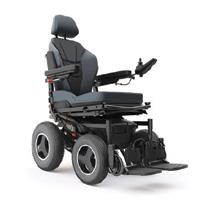
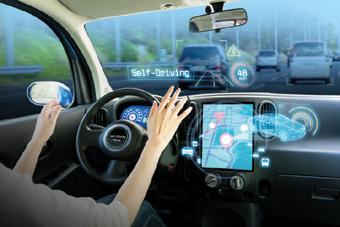







CAR
Electrifying the Future
The Evolution of Electric Vehicle Infrastructure
By Rahul Mittal
The electric era is here and it’s all about infrastructure. As global consciousness shifts towards sustainable practices, electric vehicles (EVs) are rapidly becoming the transportation mode of choice. This transformation, however, is not just about the vehicles themselves but also about the infrastructure that supports them. From charging stations to battery production facilities, the backbone of the EV revolution is its infrastructure.
The Current State of EV Infrastructure
The year 2022 was a watershed for the EV industry. Electric car sales globally exceeded the $10 million mark. Leading this electric charge was China, leveraging its vast manufacturing base and proactive government policies. It accounted for a staggering 60% of global electric car sales. Europe wasn’t far behind, witnessing a 15% surge in sales, translating to one in every five cars sold being electric. The United States, while starting from a smaller base, saw an impressive 55% growth in electric car sales, capturing an 8% market share.
While the dominant players continue to grow, emerging markets like India, Thailand, and Indonesia are showing promising signs. These nations tripled their electric car sales in 2022 compared to the previous year, reaching a combined total of 80,000 units. India’s government, recognizing the potential of EVs, has rolled out a USD $3.2 billion incentive program, which has already attracted investments totaling USD $8.3 billion.
The Growth of Infrastructure
The proliferation of EVs necessitates a robust charging infrastructure. As the number of EVs on roads multiplies, cities globally are ramping
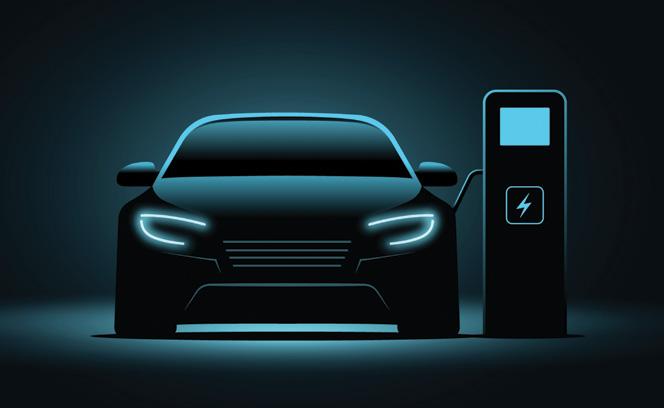
up their efforts to install public charging stations. These stations, equipped with the latest fast-charging technology, aim to make charging as convenient as refueling at a traditional gas station. Furthermore, home charging solutions are also gaining traction, allowing users to charge their vehicles overnight, ensuring they start each day with a full battery.
The battery is the lifeblood of an electric vehicle. As EV adoption rates soar, there’s a parallel surge in battery manufacturing. By March 2023, the announced battery manufacturing capacity for 2030 seems poised to meet, if not exceed, the projected demand. But it’s not just about quantity. Research and development in battery technology are in overdrive. The focus is on increasing energy density, reducing charging times, enhancing safety, and ensuring the batteries have a minimal environmental footprint.
The Future of EV Infrastructure Governments worldwide recognize the potential of EVs, both from an environmental and economic perspective. The European Union and the United States have recently implemented policies aimed at bolstering their EV infrastructure. The EU’s new CO2 standards and the U.S.’ Inflation Reduction Act are expected to be significant demand drivers. These policies, combined with incentives like tax breaks and rebates, are set to supercharge the EV revolution.
By 2030, the landscape of urban transportation is set to undergo a sea change. Current projections suggest that electric car sales will constitute 35% of all car sales. This growth will necessitate a corresponding expansion in infrastructure. We can expect to see multi-modal charging solutions, integrating public transport, personal vehicles, and shared
48 INNOVATION & TECH TODAY | VOL. 9 / ISSUE 2 CONNECTED
Photo: iStockphoto/Kolonko


mobility solutions. Battery swapping stations, currently in their infancy, might become commonplace, offering users the ability to “refuel” their vehicles in minutes. By 2030, the total installed LDV charger capacity is projected to grow more than ninefold to 1.9 TW in certain scenarios.
Key trends and Developments to Watch For
Increased Charging Speeds: Technological advancements will likely lead to even faster charging times, making EVs more convenient for long-distance travel.
Expanded Charging Network: Governments
and private companies will continue to invest in expanding the charging infrastructure, ensuring that EVs remain accessible to all.
Vehicle-to-Grid Integration: EVs may play a crucial role in stabilizing the electrical grid by providing power during peak demand and storing excess energy during off-peak hours.
Autonomous EVs: The convergence of autonomous driving technology and electric vehicles could revolutionize transportation, making it safer and more efficient.
We may see the development of wireless charging technologies and solar-powered charging stations. Also, expect more charging
stations integrated into existing infrastructure, such as parking garages and streetlights.
Influential Demographics and Urban Planning
Urban areas, with their dense populations and shorter commute distances, are the primary adopters of EVs. City planners are integrating EV infrastructure into their urban development blueprints. From dedicated EV lanes to charging stations in public parking areas, the city of the future is being designed around the electric vehicle. However, the growth in emerging markets indicates that rural areas are not far behind. With the right mix of policies and incentives, rural EV adoption can witness exponential growth.
Environmental Impact and Sustainability
The shift to EVs is not just a technological transformation; it’s an environmental imperative. Traditional vehicles, powered by fossil fuels, are significant contributors to global greenhouse gas emissions. EVs, on the other hand, have a much smaller carbon footprint, especially when charged using renewable energy sources. The growth of EVs, combined with a shift towards green energy, can play a pivotal role in combating climate change. In 2022, electric vehicles enabled a net reduction of approximately 80 Mt of greenhouse gas (GHG) emissions on a well-to-wheels basis. This reduction is significant, considering the global push to combat climate change. The rise of EVs also means a reduction in the demand for oil. Based on existing policies, oil demand from road transport is projected to peak around 2025. By 2030, electric vehicles are expected to displace over 5 million barrels of oil per day.
The electric revolution is a holistic transformation. It’s not just about the vehicles but also about creating a sustainable ecosystem to support them. As we accelerate into an electric future, the growth and evolution of infrastructure will play a crucial role in determining the pace and success of this transformation. The next decade promises to be an exciting phase in the journey towards a cleaner, greener, and more sustainable future. ■
INNOVATION & TECH TODAY | VOL. 9 / ISSUE 2 49
CONNECTED CAR
Photo: iStockphoto/Shutter2U

Embracing the Sun
Remarkable Advancements in LightYear Solar-Powered Cars
By Shravan Kumar Reddy Poli
The automotive industry is making tremendous advancements in technology after the electric vehicle buzz. Now, it is all about solar-powered cars. Revolutionizing the automotive industry, LightYear solar-powered cars are paving the way toward a greener and more sustainable future. These innovative vehicles harness the power of the sun to propel us forward into an era of ecofriendly mobility and energy independence. These cutting-edge vehicles combine advanced solar technology with electric mobility to create a clean, efficient, and eco-friendly mode of transportation.
Engineers at LightYear have developed advanced solar panels with enhanced efficiency integrated into the vehicle’s body. Solar cells capture sunlight and convert it into electricity — the key to this innovation is channeling the power to the car’s electric drivetrain and charging the battery as the car is driven.
The LightYear 0, formerly known as LightYear One, is the first production-ready solar-powered vehicle with significant technological advancement. By supplementing an already proven electric battery with solar energy, LightYear cars show impressive ranges that rival their traditional counterparts. The combination of solar power and regenerative braking ensures every bit of energy is captured and utilized to its fullest potential. In addition to solar-powered cells, their lightweight design and aerodynamics further enhance their efficiency, enabling them to go the extra mile without worrying about charging stations.
LightYear Solar Panels
Let’s dive a little deeper into the solar panels used by LightYear 0. Solar panels are made of monocrystalline silicon, which is the most efficient type of solar cell. Panels are very
lightweight which improves their efficiency.
With the combination of different factors including the car’s aerodynamic shape and lightweight design, LightYear 0 achieved a drag coefficient of 0.19, which is among the lowest of any production car in the market. It is very aerodynamic and can travel long distances with minimal energy consumption. This is going to be a boon for the future with energy scarcity.
Charging and Range
What concerns most customers is how often a solar-powered vehicle should be charged. The LightYear 0 has a range of 388 miles with a single charge. Its solar panels on the roof and hood can generate about 43 miles per day in ideal conditions.
It has a battery pack with 60KWh capacity. This is a relatively small battery pack compared to any electric cars that are in production, but it is sufficient for the Lightyear 0’s range. It is equipped with four independently controlled inwheel motors, allowing the car to distribute power more efficiently and improve its handling.
With such technology and a spacious interior, the car’s MSRP is around $263,000. Despite its high price, the Lightyear 0 is a promising step toward the future of solar-powered cars. As the technology continues to develop, and with mass production, the cost of solar panels will likely come down.
Challenges for Mass Adoption
Before it becomes more affordable and has a major impact on the future of transportation some challenges need to be overcome. The cost of solar panels is a significant contributor to solarpowered vehicle prices. We all know with government subsidies solar panel costs have been declining in recent years. Let’s hope it continues to decline and make solar-powered cars more affordable.
The current range might be decent, but solar panel efficiency needs to be improved to attract and become mainstream.. As the efficiency of solar panels improves, solarpowered cars will be able to generate more electricity from sunlight, which will increase their range and make customers less concerned about charging.
As more people start using solar panels, the availability of sunlight needs to be taken into account. It is obvious that the availability of sunlight varies depending on the location, in some places there is a lot of sunlight throughout the year while in other places there is less sunlight for several months. This means the range of travel for solar-powered cars will vary depending on the location in which you drive.
There is currently a lack of infrastructure for charging solar-powered cars. Electric charging stations are being developed but infrastructure for charging solar-powered cars needs to be developed. This means that solar-powered car owners will need to be able to charge their cars at home or public charging stations. This will be a significant challenge to owning a solar-powered car without infrastructure development.
Will these challenges crush the dream of solarpowered transportation? Probably not. If these hurdles can be overcome, solar-powered cars could have a major impact on future transportation and become mainstream.
LightYear’s commitment to pushing technological boundaries is clear evidence that they’re pursuing having some of the first solarpowered cars on the road. This development not only propels green renewable energy and electric vehicles but will inspire other industries to adopt sustainable practices to show their presence in the market. ■
50 INNOVATION & TECH TODAY | VOL. 9 / ISSUE 2 CONNECTED CAR
Photo: iStockphoto/maxdis
The MaxJax portable two-post lift is one of the most versatile DIY tools ever invented. Its patented design allows you to get fullsized lift advantages in spaces with limited ceiling heights. Best of all, MaxJax is completely portable and can be setup virtually anywhere. For more info call 1-844-629-5291 or visit www.MaxJax.com Model:
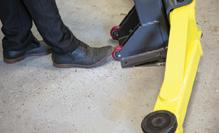

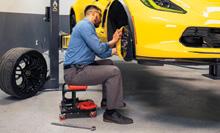
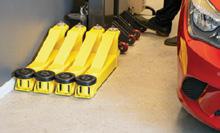






SEE IT IN ACTION autostacker.com • 1-888-977-8225 © 2024 BendPak Holdings LLC. A wholly owned subsidiary of BendPak, Inc. Autostacker is protected by one or more patents in the United States, China, Europe, and other countries.
at *$10,895 INCLUDES **FREE SHIPPING Revolutionize your Home Garage Autostacker is designed to maximize space in your home garage while offering safety and convenience to car storage. Featuring a low-profile entry ramp that handles autos like other lifts wish they could. With its intuitive safety features and sleek design, Autostacker is truly worthy of your garage. Low-Profile • Sleek • Safe *Prices valid until 03/31/24.**Applies to direct shipping points within the 48 contiguous United States only.
Starting
Low Ceilings?
See it on YouTube
Portable, Reliable NEW Lift Capacity Starting at $3,895* INCLUDES FREE SHIPPING** Lift Capacity: 7,000 lbs. Lifting Height: 48” Lock Positions: 7 Min. Height: 4.5” 1-844-629-5291 • www.MaxJax.com © 2024 BendPak Holdings LLC. A wholly owned subsidiary of BendPak, Inc.Patent NO. US 8.256.577 B2 and US 9.150.395 B2. Price valid until Mar. 31st, 2024. **Free shipping to direct shipping points within the 48 contiguous United States only. WORK IT STOW IT ROLL IT
M7K
Durable,
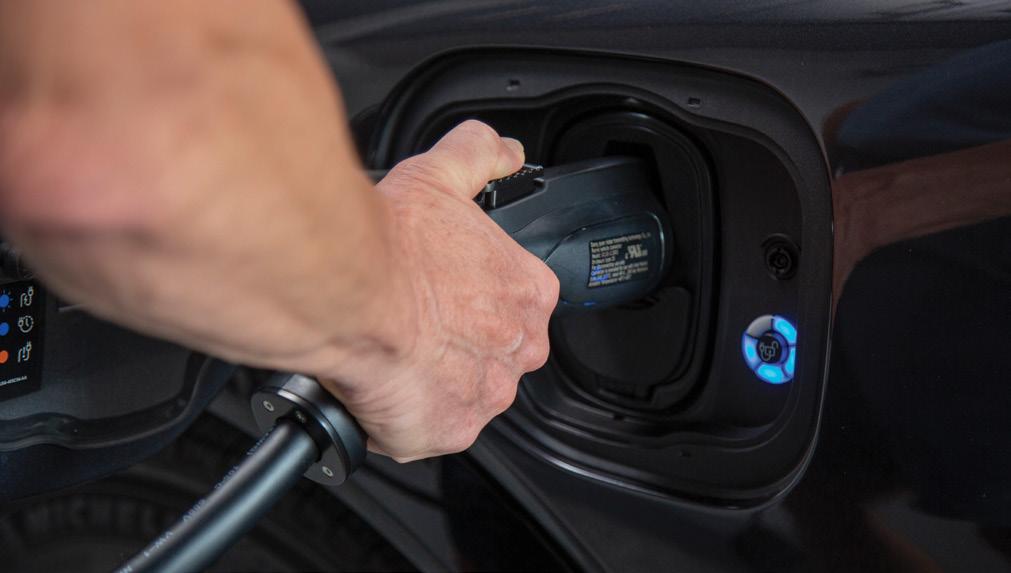
POWERING FORWARD
Navigating the World of Electric Vehicle Charging
By Lindsey Feth and Kevin Kohl
When considering the investment in electric vehicles, many express interest but struggle with the initial steps of setting up an electric vehicle charger. Kevin Kohl is the director and product manager at Legrand. Being a top specialist in electrical and digital building infrastructure, Legrand aims to support the change from gas to electric vehicles by debunking the public’s common misunderstandings about EV charging. In this article, Kohl takes the expertise he’s learned from working with Legrand and lays out some essential information for
those interested in electric vehicles and the charging setup opportunities that come with them. Kohl’s insights (as follows) can help you understand how to invest in this technology by highlighting which setups are best for certain lifestyles and outlining the fastest charging solutions available.
The Best EV Charger Setup
Installing an EV charger at home creates easy access to electric vehicle charging, and in general, it’s a great solution for future-
proofing your house and increasing potential resale value down the line. For a plug-in EV charger, the initial investment is minimal. To begin, you simply need the right outlet, making this charger the easiest to invest in to start charging at home. If you want to charge your car at a faster rate, then a hardwired EV charger is the better choice. You can work with a professional for this installation.
To set up a plug-in EV Charger in a residential area, the house, garage, or yard requires a NEMA 14-50 outlet. This type of outlet is
commonly found in electric dryers, ranges, recreation vehicles, and more. These outlets are needed for setup for Level 2 charging speeds. When planning an outdoor charger setup, a weather-resistant version of the NEMA 14-50 outlet is required to avoid electrical issues.
For most models, individuals can plug the charger’s cord into the appropriate outlet and attach the unit to a stud on the wall. For weather-proofing, the simplest solution is to install the EV charger inside. Outside is also an
52 INNOVATION & TECH TODAY | VOL. 9 / ISSUE 2 CONNECTED CAR
option so long as the charger has an appropriate outdoor rating (such as NEMA 3R) and can be mounted against an appropriate surface.
Fastest Charging Solutions for Electric Vehicles
Presently, there are three charging levels: 1, 2, and 3, commonly referred to as DC, or Direct Current, fast charging. Level 1 chargers make use of standard outlets, resulting in slow and less reliable charging.
Conversely, Level 2 chargers utilize a dedicated 240V power source, guaranteeing faster and more reliable EV charging. This choice provides convenient, stress-free charging between sessions and represents a costeffective alternative to Level 3 DC charging, which is fastest and more typically seen in roadside and on-the-go cases.
Factors to Consider When Choosing an EV Charger
When choosing an EV charger, we recommend a simple set of steps to make the best decision for your home and vehicle. First, it is extremely important to do a compatibility check between your electric vehicle and the chargers that work for your model. For example, with some vehicle types, an adapter is necessary.
Secondly, you’ll want to consider which charger level to invest in. Most EVs come with Level 1 chargers, but Level 2 chargers are much faster (four times as many miles per hour!) and can be easily installed in the home. Unlike a Level 1 charger, Level 2 chargers are more frequently permanently affixed to wall surfaces and have
charging cables at least 18 feet long. Level 2 chargers often qualify for utility rebates, so it’s the type we recommend in most cases.
Third, consider where you want to install the EV charger, as that will impact which choice you should select. This step is broken down into a few considerations. Most importantly, you’ll want to consider what’s most convenient. If you park in the driveway every night, then lean into that and plan for an outdoor EV home charging station. If you always drive in and park in the left spot of your garage, you’ll want to go for an indoor option that can accommodate that routine and layout.
Many of the EV home chargers available are conveniently designed to be installed indoors or out, but the accessories of the installation can vary to ensure electrical safety in a specific environment.
It’s also important to consider the reach of the charging cable: Can it also even reach multiple spots in the case of multi-driver homes? And, on the flip side of those points, how easy will it be to store the cable and keep it out of the way when you aren’t charging? This line of questioning may seem overkill, but it is the EV equivalent of pulling up to the wrong side of the gas pump!
Finally, you’ll want to look at the features that are important to you to make your EV charger selection. Safety is key here since this is an electrical product: make sure your charger choice has been rigorously tested and certified and

that it’s manufactured by a brand you trust.
Hardwired Solution vs. Plug-In Charger
Hardwired EV chargers allow for an electrical vehicle to be powered directly into an electrical source. In turn, the hardwired EV chargers can boost rates and range to fully recharge a vehicle in 6-8 hours and get drivers up to 46 miles per hour of charging (depending on vehicle make and model). Aside from speed, hardwired EV chargers are permanently wired into the home’s electrical infrastructure, which can help to improve a home’s resale value.
While their charging speeds are not as quick, plug-in Level 2 EV chargers still pack a punch! Plug-in models offer a more versatile solution, allowing a charger to connect to a standard 240-volt outlet to charge an electric vehicle. This is enticing
The Legrand Plug-In Home Level 2 EV Charger offers a secure, straightforward, and effective method for charging any electric vehicle in your home.
for folks who may be considering a move and would like to take their charger with them or for those “techies” who look to stay leading-edge and may upgrade their equipment easily over time.
Impacts on the Electric Bill
Surprisingly, it is cheaper to charge an EV (by hundreds of thousands of dollars!) than it is to fill up a gas-powered vehicle. The difference between the two amounts depends on location, but charging an EV is cheaper in most parts of the United States. One reason for this is that gas prices fluctuate so frequently, whereas EV chargers have fairly stable prices.
Another benefit of at-home EV chargers is that you can obtain rebates and tax credits from incentive programs instituted by federal, state, and local governments. ■
INNOVATION & TECH TODAY | VOL. 9 / ISSUE 2 53 CONNECTED CAR
Tech in the Lone Star State
Why Austin is the New Tech Hub
By Lindsey Feth

While many might have stereotypes of Texas as being all about barbeque, southern hospitality, country music, and an epicenter for oil production, the Lone Star State is an innovative center for all things tech. In recent decades, cities such as Houston, Dallas, and San Antonio are making new headways for tech to explode and become more and more relevant and inventive as the times change. But Austin is one specific city that’s been making extreme progress in the tech industry that keeps growing at unprecedented rates. After experiencing the internet boom in the 1990s, Austin proliferated with telecommunication firms and information technology. The city is pushing the tech industry forward with groups like Capital Factory, Opportunity Austin, and more. But what are the reasons for these changes in Austin, and why is tech booming in the flourishing city? Here’s what we’ve found:

Immense Population Growth
Between 2010 and 2020, Austin, Texas, experienced a growth rate that’s more than five times the United States population growth, which amounted to 33.7%. To put this into perspective, the growth rate in Austin alone is more than double the population increase of Texas itself, which saw a 16.8% growth rate in 10 years. According to the United States Census, Austin had a population of 1.24 million in 2000 to 2.29 million in 2020. As of 2023, Austin has experienced a population growth of 2.39% in just one year. With more and more people moving to this flourishing city, tech companies have abundant choices for talent to hire and collaborate with to make their business goals a reality in the major Texas city.
54 INNOVATION & TECH TODAY | VOL. 9 / ISSUE 2 REGIONAL SPOTLIGHT Texas
Photos: iStockphoto

Great Business Resources
Tech companies in Texas have business resources and perks that aren’t in other locations. For example, the Lone Star State offers massive amounts of purchasing power and decreased costs for operations. The result of these working conditions: higher profits! Especially for tech companies who have highpriced infrastructure, these benefits are too good to pass up.
In addition, Texas also offers corporatefriendly tax incentives, which permit small to midsize enterprises to be inventive and catch up with tech giants that already established their work in the area. With this direct support to small businesses and startups, the network needed for immediate tech support isn’t hard to find.
Texas offers specific benefits for businesses in the tech industry. By offering tax breaks and incentives, the area is the perfect place for tech enthusiasts to begin dreaming big and establishing their tech companies with innovation. For example, Texas offers a 100% exemption of sales tax for essentials for data centers like media equipment, power infrastructure, electricity, and power infrastructure. To receive these benefits in Texas, the data centers must meet specific guidelines such as making $200 million in capital investment, 20 new jobs, and an average salary that’s 120% of the U.S. average salary.
Employees can also experience some benefits. If an individual works in Austin, there will be no corporate income tax due to the low state taxes and amenities. There is also capital funding available for individuals, not just businesses. With this considered, anyone can expand their business in Austin, Texas.

Many Education Opportunities
For any location to become the new tech hub, it’s essential for there to be education opportunities, and Austin has them. The strong push for education is most evident when exploring the plethora of world-class universities in the city, such as Southwestern University and Texas State University.
The University of Texas at Austin is a star staple for tech education in the city since it has esteemed computer science programs. Students at this university research tech in real time, intern at top companies, network with recruiters, and go to industry conferences that help them get their foot in the door before even receiving a diploma.
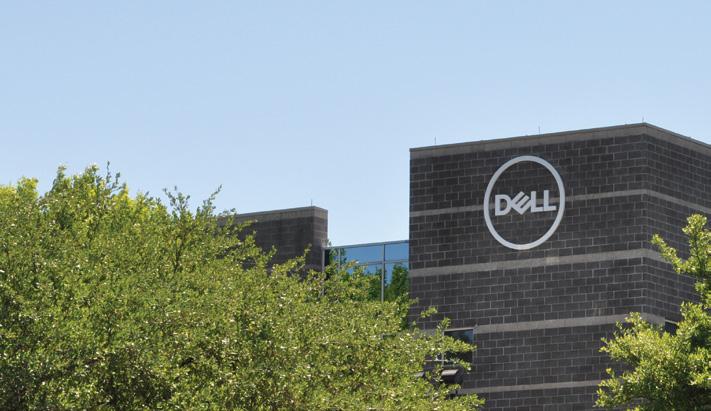
Big Tech Dominates
When exploring what ignited Austin’s tech boom, it’s paramount to consider Dell Technologies. After being founded by Michael Dell, a University of Texas in Austin student, in 1984, Dell swiftly grew globally. With its quick success, Dell was the magnet that pulled in other tech companies, suppliers, and vendors to Austin. Soon enough, entrepreneurship became a norm in Austin, and creativity seemed to come second nature for eager innovators who moved to the area.
In addition to the influence of Dell Technologies, IBM, Tivoli, Texas Instruments, and others have also left their mark on the city and have inspired other tech enthusiasts to plant their feet in the city.
The inspiration is still multiplying with tech giants such as Google and Apple in the city, making it the perfect spot to nail a dream job and learn from some of the most prominent tech developers in the world.
INNOVATION & TECH TODAY | VOL. 9 / ISSUE 2 55 REGIONAL SPOTLIGHT Texas



Elevated Living Standards
The elevated living standards in Austin attract talented tech enthusiasts and companies alike. While pricing has increased in the past decade, it’s still more affordable than locations like Boston, New York, and Los Angeles. In addition to the financial aspects, Austin is the home of a diverse population that offers a wide selection of cultures that come together and create a dedicated community that puts in the effort to make the city thrive.
The health and fitness community is one of the most prominent in Austin, with activities such as biking, kayaking, swimming, running, and hiking being normal activities during local’s free time. The live music scene attracts newcomers with many options in the Moody Theater, The Saxon Pub, the Paramount Theater, and the Empire Control Room. Plus, Austin is known for its low crime rate. With Austin having rates lower than the national average for crime, areas such as Hyde Park, Old Enfield, and RollingWood are top options in the city to move to.
Employment Opportunites
When combining the great business resources and the tech culture, it’s only right to assume the employment opportunities are great in Austin. According to the Texas Workforce Commission, Austin’s employment growth has remained above the U.S. and Texas as a whole between 2010 and 2020.
Austin had a total of 9,800 employers that were affiliated with the tech industry as of 2022, which amounts to 195,879 jobs created. When put into percentages, Austin’s tech employment equals 16.3% of the entire population!
The Future of Austin
Austin is a key trailblazer for other U.S. cities wanting to embrace the rise of tech. But what else will Austin do besides inspire in the future years? For one, Austin will continue to see companies and tech startups planting their roots in the city and providing more job opportunities.
Additionally, Austin is predicted to attract the younger generations in upcoming years, which will meet these job position demands tenfold. Big tech companies in Austin, such as Indeed, Dell, and SolarWinds, will continue to thrive in upcoming years.
The future of Austin will also be a monumental location for the development and research of rising tech, such as robots, artificial intelligence, biotechnology, self-driving cars, and machine learning. So, let’s sit back and continue to see how Austin redefines the tech industry!
REGIONAL SPOTLIGHT Texas
56 INNOVATION & TECH TODAY | VOL. 9 / ISSUE 2


American Manufacturing
Women in the Lone Star State
By Gretchen Philyaw, President & CEO of Magenta Technologies LLC
American manufacturing is ripe for a renaissance. We are in a new revolution in the industry. Electric vehicles, drones, AI, AR & VR applications, robots, and 3D-printed organs are just the tip of the iceberg. It is the next wave of manufacturing and technology solutions.
There are challenges in the industry, and it is easy to talk about the issues. There is a divide between commerce initiatives, industry, and academics. Instead, I am here to share my thoughts on how to work together to solve tough issues through collaboration, innovation, and a new way of thinking — to bridge this gap and create a cohesive plan.
Truly, the solution is pretty easy. We just need more STEM talent to fill the skill shortages in STEM-related fields. This gap is growing, and we need to reverse the trend to solve the technical challenges related to the manufacturing and technology industries.
Is there a solution or an easy fix? Yes! We need more women.
More Women
Men aren’t filling all of the required jobs. We need women to fill in the gaps. The widening
shortage of STEM workers can’t be solved unless we bring more women into the industry.
There are women currently in the manufacturing industry who are fantastic role models. My goal is to highlight these women to help attract aspiring young women into STEM roles.
Gina Norris, President of CForce Bottling Company in Navasota, Texas, is one such woman. CForce Bottling Company was formed in 2015 by Gena and Chuck Norris after discovering the most unique water in the world, directly under their land 70 miles north of Houston. Looking for ways to fund their non-profit, Kickstart Kids (which has graduated over 117,000 underprivileged Texan youth to date), the Norris formed CForce and built a 100,000 square feet bottling facility directly above the source — where they bring in recycled plastics and turn them back into bottles, before filling each one. CForce is now in over 35 states and continues to support Texas youth.
Gina Norris is a driving factor in CForce and at the apex of women who inspire in manufacturing and the world. She is driving home the key points of how we will bring more women and young girls to the industry:
• Start early. Plant the seeds early (elementary school)
• Provide role models & mentors to these aspiring young women
• Create programs that are exciting and compelling
• Create corporate partnerships committed to supporting women in STEM
• Support women throughout their careers
We need more talent like Gena Norris. We need women who are empathetic leaders who drive home the need to foster our youth while moving technology forward. That is the future of this industry.
My career is centered around robotics and industrial automation. I see what I do and what other amazing women do every day is making American manufacturing and technology more competitive, and we are doing it more sustainably. I see the need for great acceleration in advancing technology across all STEM-related industries.
We need a renaissance in manufacturing and technology. We need more women. ■
58 INNOVATION & TECH TODAY | VOL. 9 / ISSUE 2 REGIONAL SPOTLIGHT Texas
Photo: iStockphoto/SeventyFour
Tech is Bigger in Texas
Compiled By I&T Today Staff
867,278 working tech jobs —
6.2% of the state’s total workforce.
In 2022, net tech employment grew by 45,331 workers, representing an increase of 5.5%
CompTIA predicts a 4.4%increase — 38,438 new jobs — in tech employment for 2023.
There are
44,330 tech businesses in the state.
2,310 tech businesses opened in 2022.
The tech industry delivers $158.7 billion 7.7% of the state’s total annual economy.
Diversity in Tech in Texas. Percentages are the state’s tech workforce.
26% Women 17% Hispanic or Latino
Source: CyberSates.Org
9% Black or African Americans
Bythe Numbers
Texas is experiencing a tech revolution, shaping the future of innovation and employment in the state and beyond. The Lone Star State is a hub of American ingenuity, especially in Austin. These developments come from the workforce's ripened skill set and education commitments. The statistics below show the fast-growing employment rates, the top tech companies, and more. After reviewing these impressive numbers, the commitment to fostering and nurturing a tech-centric future is evident.
7% of total U.S. patent applications from Jan. 2018 to Sept. 2020 were Texas-based inventors.
Major centers of high-tech employment:
#2
Texas ranks second (of all states) based on the share of patent filings.
9% of nationwide high-tech employment is in the Lone Star State.
Austin makes up less than 1% of U.S. employment, but its share of the nationwide patent filings and high-tech employment is double.
College-Educated Workers Ages 25-65 31% 37% 2012 2023
Source: Federal Reserve Bank of Dallas
Top Tech Companies
Source: Built in Austin

Dallas and Houston are the fastestgrowing tech centers in the United States.
Source: KubrickGroup
Cloud computing jobs increased from 7% in 2012, to 11% in 2022.

Live Music Capital of the World — Austin’s Tech Stats
for the highest concentration of software engineers and tech talent within the tech industry
#3 Tech workers yearly salary $104,000 an 18% increase in 5 years. The highest paying tech role (computer and IT systems manager) has a yearly salary of $164,770 Experienced a 52% increase in tech workers from 2016 to 2021.
Source: Austin Business Journal
REGIONAL SPOTLIGHT
4% Dallas–Fort Worth 2% Houston 2%
Austin
INNOVATION & TECH TODAY | VOL. 9 / ISSUE 2 59
The Future of Entertainment
U2’s Performance at LV Sphere Showcases the Power of Innovation
By Charles Warner and Lindsey Feth
What do you picture when thinking of Las Vegas? It’s likely gambling, spectacular fine dining, and unmatched entertainment opportunities.
The city is iconically known as the Entertainment Capital of the World. And it’s no surprise that Las Vegas quickly embraces new tech and the innovative opportunities it brings to improve the things that already make the destination great. These initiatives inspired the creation of the Sphere.
The Sphere is a tech marvel, the latest hub for entertainment. It’s redefining the industry and taking the musical experience to a new level for the audience. The Sphere is the beginning of an era. By integrating extraordinary tech, an iconic rock band, and some creative geniuses, the creators have engineered a state-of-the-art debut show series that the world can’t ignore.
The Sphere’s Cutting-Edge Technology
The Sphere’s unprecedented tech is breaking more than one world record! It’s the largest spherical structure on the planet, measuring 5.7M cubic feet in the main atrium. The LED screen comprises 268,435,456 video pixels, which is unprecedented. With the help of this tech, the screen’s resolution is equivalent to 72 HD televisions combined, meaning every minute of content is the same as one hour of streaming television. The Sphere’s visual display wraps around the audience and expands over the seats with a 16K by 16K resolution. The 4D tech lets the audience experience visuals like never before.
The Sphere is the home of the world’s largest beamforming audio system that provides
customized listening experiences. With precision storytelling, the Sphere allows each attendee to “feel” the experience because of the clear audio, changing temperatures, and familiar scents. The exosphere has a fully programmable LED exosphere. Thanks to its innovation, the Sphere’s exterior has a 2K resolution on the Las Vegas skyline.
U2’s Debut Sphere Performance
U2’s Sphere debut is a perfect celebration of music and technology. The rock band’s Sphere performance celebrates their seminal 1991 album Achtung Baby and the industry-defining ZOO TV tour.
U2 also performs their new song Atomic City, celebrating the 70s post-punk spirit and Blondie, a pioneer who intrinsically influenced and inspired the band members. It was only right to perform the song here since Atomic City was a 1950s nickname for Las Vegas.
The initial 25 shows took place from September-December 2023. Due to unprecedented demand, the Sphere scheduled an additional 11 shows in January-February 2024. For their opening night on Sept. 29, U2 attracted VIP attendees such as Dr. Dre, Elizabeth Banks, Jason Bateman, Jimmy Kimmel, Oprah, Paul McCartney, and Snoop Dogg.
After seeing the Sphere at the beginning of construction and feeling equipped to take on the tech venue, the U2 band members used impressive innovations such as Holloplot’s audio system and the Sphere’s interior screen that revolutionized the audience experience.
Innovation & Tech Today spoke with The Edge, U2’s lead guitarist, keyboardist, and backing
vocalist to discover how the rock band integrated tech, art, and musical talent for their Sphere debut.
Innovation & Tech Today: How did you first hear about the Sphere, and what did you initially think about the concept of merging art, rock, and incredible tech?
The Edge: We first heard about the Sphere through friends who were involved, and independently via our creative team. This was back in 2020. We were unofficially asked if we would consider being the first band to perform at the Sphere. So, Bono and I came to visit the half-built venue in 2021 to see the audio-visual demos in Burbank and to meet the team.
When we saw the technology they were developing and understood the potential of the Sphere, we became convinced that developing a rock ‘n’ roll show for it was a challenge that U2 was uniquely qualified for.
I&T Today: The Sphere boasts impressive tech features. How will these technologies enhance the audience’s experience during your performances?
The Edge: The audio system by Holloplot is extremely versatile and allows for immersive audio at a huge scale. Sonically, it has all the headroom to rock the house. The building is spherical, but the ceiling is 80% permeable with huge amounts of acoustic treatment above the screen. It’s remarkably sonically controllable. We are confident it will allow for the best sound of any comparable venue.
The interior screen is what makes Sphere so revolutionary. It’s so large and at such high resolution that it allows us to virtually
60 INNOVATION & TECH TODAY | VOL. 9 / ISSUE 2 FEATURE STORY
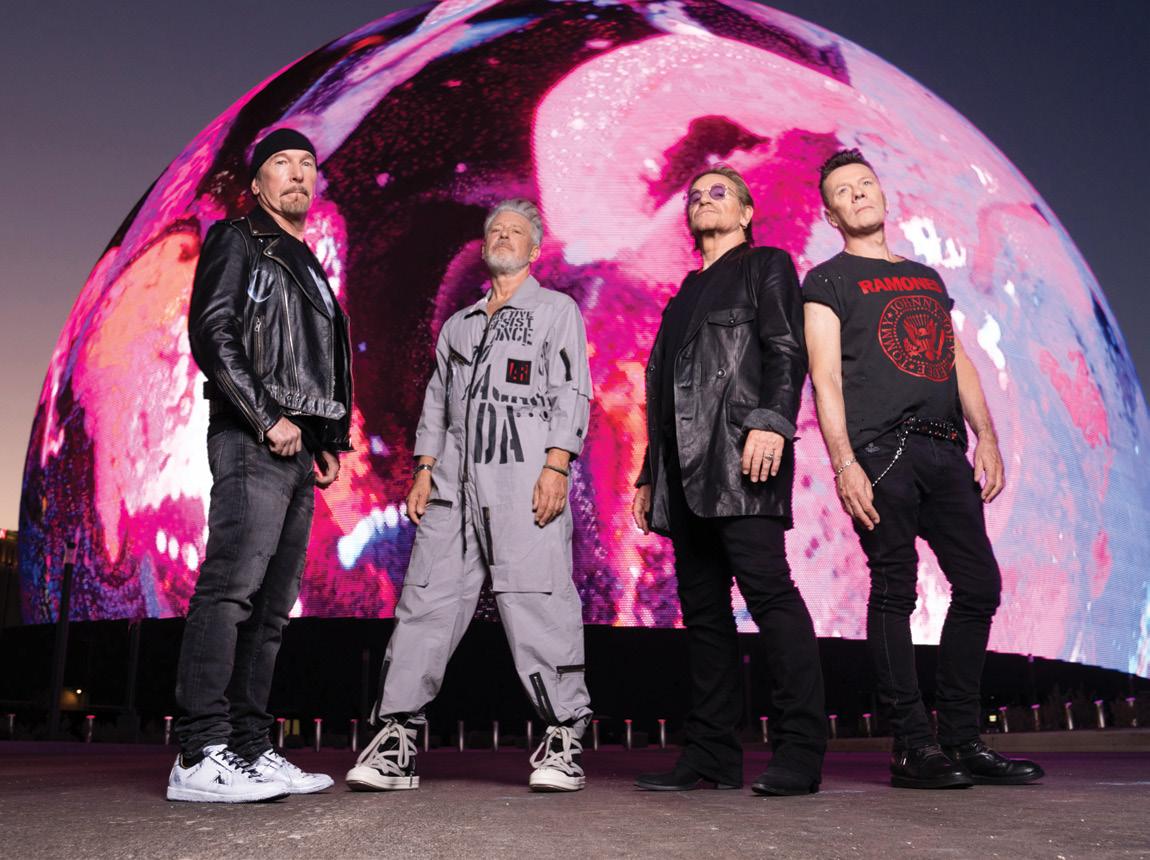
translocate our audience to a different time and place, whether an existing location, a virtual reality, or a completely made-up reality. It’s kind of mind-blowing. We anticipate that fans may experience some mild disorientation, but hopefully nothing overwhelming.
I&T Today: You are no strangers to pioneering innovation. You’ve referred to this engagement as a “venue launch.” What unique elements will U2 bring to the Sphere’s debut, and how do you envision it changing the landscape of live entertainment?
The Edge: Sphere was conceived and designed initially for immersive movie experiences, and it’s going to be amazing for that.
The reason people want to come and see U2 live is because of our songs. They are our boss and tell us what to do. Regarding the experience we are creating, it’s about looking
for how visuals might collide with our music and the band’s performance in a way that draws out some kind of heightened meaning.
When this happens in front of a live audience, it’s a very powerful thing to be part of. It’s a communal thing, like a kind of synchronized catharsis. What a lot of people don’t know is that we feel it too.
I&T Today: How do the Sphere’s innovative sound capabilities, like beamforming and wave field synthesis, affect the way you perform and interact with your audience compared to traditional concert venues?
The Edge: With the Sphere, audio system intimacy becomes available at scale. Also, we have to play super accurately because every little flaw is obvious. I think the band will have to rise to the challenge and it will add to the quality of the experience.
I&T Today: Why is music such a powerful medium to connect and move lots of people and even be a force for change?
The Edge: They say music is the ultimate art form because it requires no explanation. Music is somehow hardwired into our psyche, therefore it’s like a mainline to our emotional life. When it comes to connecting people and galvanizing action, songs are super potent. Only two regimes ever tried to ban music. Mao during the Cultural Revolution and the Taliban. Both to secure total control of the population.
When Bono and I visited Ukraine and the area formerly occupied by Russian forces, it was pointed out that there was a bullet hole in the head of a statue of famous Ukrainian poet Taras Shevchenko. They obviously understood the power that his words had to galvanize resistance to their attempt to bully
INNOVATION & TECH TODAY | VOL. 9 / ISSUE 2 61
U2 band members in front of Sphere. Photo: Sam Jones

Ukraine into submission. Music and poetry will always be a resource for the oppressed and for helping to bring about positive change.
U2’s Creative and the Sphere’s Art U2 has many creative visionaries who help make the show’s art come to life. Their imagination, with the help of some impressive tech, makes the shows an epic adventure for every audience member.
With over 40 years of live performance design experience with U2, Willie Williams is the creative director for this show series at the Sphere. Artists who contributed content for the shows include Brian Eno, Marco Brambilla, Es Devlin, John Gerrard, and Industrial Light & Magic. Each one brought something unique to the table. For example, Brian Eno created a generative algorithm that controls the stage’s color and some of the lighting. The tech makes it so that the show will have a unique color palette. Marco Brambilla’s video sequence, Even Better Than the Real Thing, features AIgenerated Elvises.
Williams and these other talented artists designed the show’s visuals with virtual reality beforehand because the Sphere was under construction during the design process. The team had to collaborate like never before, utilizing new tech to create extraordinary visuals for the Sphere’s debut.
I&T Today interviewed Willie Williams about his experience as the creative director to learn more about the design process for U2’s shows at the Sphere.
I&T Today: How was the collaborative process with the artists in creating material for the show?
Williams: We worked with a wide range of artists, some long-standing collaborators, and some new to the U2 fold. Each had quite a different experience. Embracing the collaborative process was harder for some artists than for others, but ultimately everyone understood that the show is the boss. Even for me, the ideas and designs are ultimately judged
by the show itself; the elements that work get to stay, the ones that don’t get dropped.
I&T Today: Can you discuss the challenges of designing a show within a never-before-done venue, especially since it was under construction during the design process?
WW: With this project, not only did we have to imagine an entirely new kind of show, but we also had to imagine the venue it would be performed in. Making a show like this is always the confluence of art, science, and diplomacy, but this ranked much higher on the diplomacy scale as so much was not under our control.
I&T Today: How was virtual reality used to design the show?
WW: VR proved very useful in designing the show as it was often the only option available to view what we were making. The resolution is still very low, but it was frequently helpful in deciding how big something needed to be or how fast something should move. It was also great to be able to view elements from all over
62 INNOVATION & TECH TODAY | VOL. 9 / ISSUE 2 FEATURE STORY
Atomic City music video shoot.
Photo: Sam Jones




the building without tramping up and down stairs.
I&T Today: What are your hopes for the future of immersive fan experiences like this? How does tech play a part in this?
WW: One of my favorite reviewer comments of the U2 Sphere show was along the lines of “the future of live concerts is very, very weird, but it’s also very, very live.” We are currently inundated with “immersive” experiences, which are often not very immersive and frequently not very engaging. I have always been drawn to designing for the live experience and view all of these visual elements simply as tools to enhance that.
I&T Today: Are there any special visual or audio effects that were made for the Sphere’s 4D technology and immersive sound system?
WW: From our side, the principal element of custom technical design for the visual aspect of the show was the video playback system. Treatment Studio, in tandem with Fuse, designed a bespoke system to harness together 23 of the Disguise “d3” playback systems commonly used in concert touring. This allowed us the programming flexibility we needed, along with the kind of media and camera integration required for this kind of show.
I&T Today: How did the creative team work together to have the visuals and music work together well?
WW: One of the keys to the success of the show was the band’s understanding that we were creating an ocean liner rather than a small dinghy. They were aware that large last-minute changes of direction would be out of the question and stayed engaged with me throughout the whole design process. I realize this sounds like it should be the norm, but it is very unusual in concert touring! Just rendering some of the larger video sequences took several days, so the creative process for each piece often required several months. Having the performers, and therefore the music, be such an integral part of the journey allowed us to aim much higher than we might otherwise have done. ■
64 INNOVATION & TECH TODAY | VOL. 9 / ISSUE 2 FEATURE STORY
Photo: Sam Jones Photo: Sphere Entertainment
As seen above, original band member Larry Mullen Jr. was involved in the new song and video shoot. Sphere shows feature a replacement drummer, Bram van den Berg, as Larry is temporarily unavailable due to medical reasons. Photo: Rich Fury















Capturing the Wild
An Exclusive Interview With Wildlife Filmmaker
Bertie Gregory
By Charles Warner


Wildlife filmmaker Bertie Gregory recently went on an epic 219-day adventure documenting animals in their natural habitat. With his new six-episode release of Animals Up Close on Disney+, Gregory showcases the wonders that came along with this experience. While chatting with Innovation & Tech Today, Gregory discusses the filming experience, his daily inspiration for getting up close and personal with these creatures, and what he hopes viewers will take from this new series.
Innovation & Tech Today: So, you’ve got a great show getting ready to come out that was a six-part series filmed over 219 days. What was that like?


Bertie Gregory: It was a lot of time away, but it was great. We did those 219 days within a calendar year so it was pretty epic. The most number of filming days we did for one episode was the puma episode. We did 51 days for that episode in Patagonia. In wildlife films, it’s all about time because you need to learn the habits of the animals and learn the landscape that they exist within. And then on top of that, you need to get lucky, and the more time you spend in the landscape following the animal, the greater chance you have of getting lucky. And we certainly got lucky on this project.
I&T Today: Are you guys on foot? Do you guys have like four-wheelers? How are you getting around?
66 INNOVATION & TECH TODAY | VOL. 9 / ISSUE 2
Aerial shot of Australis sailing between two large ice sheets. (credit: National Geographic for Disney+/Bertie Gregory)
Aerial shot of a Pod of killer whales swimming towards an ice flow. (credit: National Geographic for Disney+/Bertie Gregory)
Bertie Gregory on board the Australis, looking over the edge of the ship. (credit: National Geographic for Disney+/ Will West)
A glacier rising out of the ocean, with a killer whale breaching the water’s surface in front. (credit: National Geographic for Disney+/Tom Walker)
BG: Yeah, so in that case (puma episode), there’s like a road that ran through her main core territory. So we’d drive in 4x4s every day, and we’d be scanning from a bunch of different viewpoints, whether that be tops of mountains with good views or from the road. And as soon as we found her, there was no road network where she was. So yeah, we’d lead with cars and then carry everything we needed.
I&T Today: That’s amazing. What got you into this amazing, incredible, super exciting career field? Like, did you have some inspiration coming up? Were there any big people that inspired you to want to get into this field?
BG: My family. I’ve got my mum, dad, and three brothers. They’re all obsessed with water sports and being in the ocean. So from a really early age, I was always thrown into the sea, and I grew up sailing and surfing. I think when you spend that amount of time in the ocean, cold and wet, you gain an appreciation for it and a love for it.
As I grew up, I started to get obsessed with the natural world and figuring out how to sneak up on animals. When I was a teenager, I started taking pictures of the animals that I was obsessed with because I found that was a great way to channel my obsession.
I&T Today: One thing that I find that’s universal is that people love animals. It doesn’t matter where you’re from, your political background, or anything like that. People love animals. Why do you think that is?
BG: Well, I think because we’re animals ourselves. We’ve got this innate caveman and cavewoman instincts deeply buried in our DNA. We love the view of the ocean. We love the sound of bird songs. That is unanimous across humans. And I think because modern-day society is so disconnected from nature, a lot of people lose that connection.
And I think that’s the power of wildlife documentaries — it’s a chance to reconnect people, to re-fuse those neurons that maybe haven’t been activated in a long time. And I hope when people watch Animals Up Close, they come away just feeling really excited about the natural world and how amazing some of the animals that we live alongside are. ■

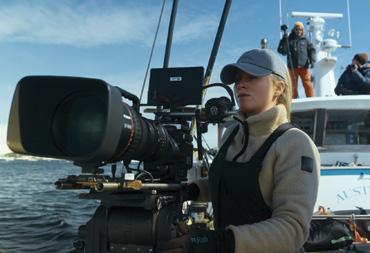

Two


Wide
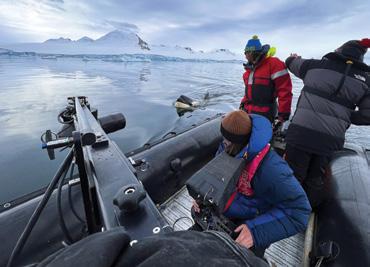

Two
INNOVATION & TECH TODAY | VOL. 9 / ISSUE 2 67
Side view of a killer whale on the surface of the water. (credit: National Geographic for Disney+/Tom Walker)
shot of Bertie Gregory standing at the front of the Australis, leaning on the railings. (credit: National Geographic for Disney+/Tom Walker)
Weddell Seals on the snow. (credit: National Geographic for Disney+/Tom Walker)
Tom Walker operating the gimbal camera as a killer whale swims past the boat. (credit: National Geographic for Disney+/Calumn Stronach)
Anna Dimitriadis filming from the front of the Australis. (credit: National Geographic for Disney+/Will West)
The crew on the rib filming Bertie Gregory as a killer whale comes to the surface at the rear of the boat. (credit: National Geographic for Disney+/Leigh Hickmott)
killer whales, one just underneath the surface and the other on top with a rainbow light glinting through the water. (credit: National Geographic for Disney+/Bertie Gregory)
Generative Artificial Intelligence in K-12 Education
Balancing Benefits, Concerns, and Ethical Use
By Texas Education Technology Leaders
The integration of generative AI in K-12 public education has the potential to revolutionize the learning landscape. AI technologies offer a wide range of benefits, enabling educators to personalize instruction, enhance student engagement, streamline administrative tasks, and facilitate effective decision-making processes.
Personalized Learning Experiences
Personalized learning fosters a deeper understanding of content and nurtures selfdirected learning. AI can analyze individual student strengths and weaknesses, and individual learning styles and provide real-time feedback.
Generative AI can create customized learning materials, including text, videos, and interactive exercises, customized to suit each student’s learning style and level of understanding. This content can be adapted based on student progress and personalized feedback, ensuring they receive appropriately challenging and engaging materials. Generative AI can analyze a student’s learning history and performance data to recommend personalized learning pathways, suggesting the most suitable sequence of topics and activities for each student by analyzing individual learning patterns and preferences. AI can recommend personalized resources, reading materials, and supplementary content to students. For students with special needs, generative AI can create personalized learning resources that cater to their specific requirements, enabling a more inclusive and supportive educational environment.
With the help of generative AI, students can learn at their own pace, allowing them to revisit concepts or progress faster as needed. This flexibility ensures that no student is left behind or held back based on the standard pace of the

classroom. AI algorithms can identify learning gaps and misconceptions in a student’s understanding by analyzing their responses and performance data. Educators can then provide targeted interventions to address these gaps and support students’ academic growth.
AI-Powered Assessments
Differentiated assessments allow educators to empower students to own the assessment process. A variety of assessments can be used to measure student learning using AI with more efficiency, accuracy, and effectiveness than traditional assessments.
Adaptive testing can efficiently identify areas
of strength and weakness, and provide a more accurate measure of a student’s abilities.
Adaptive Testing using AI algorithms can measure student proficiency and performance by creating appropriate questions for the students. Educators can modify questions to challenge students.
Intelligent tutoring systems use AI to track student progress and adjust the difficulty level of tasks to match their abilities. AI tutoring gives educators the ability to individualize learning for students. Educators can measure and identify student strengths and weaknesses based on data analyzed with AI. Educators can
68 INNOVATION & TECH TODAY | VOL. 9 / ISSUE 2 PRODUCED IN PARTNERSHIP WITH
Photos: iStockphoto
recommend personalized learning pathways and provide resources or interventions to support student learning. AI-powered virtual tutors can act as personalized guides, addressing students’ questions, providing explanations, and offering support whenever needed. These tutors can adapt their teaching styles to match the student’s learning pace and preferences.
Data-Driven Decision Making
AI’s data analysis capabilities can potentially transform the way education institutions make informed decisions. By processing vast amounts of student data, AI can identify patterns and trends, helping teachers and school leaders identify areas of improvement and design targeted interventions. School administrators can also utilize AI to optimize resource allocation, forecast enrollment trends, and make data-backed policy decisions, leading to more efficient and effective educational practices.
Enhanced Educator Efficiency
AI has the potential to streamline routine administrative duties for teachers, such as grading, attendance and lesson planning, allowing them to allocate more time and attention to individual student needs. This efficiency, in turn, fosters stronger teacherstudent relationships and enables educators to implement more creative and innovative teaching strategies. Using AI automated feedback, and grading to track student progress,

provide feedback and automate the grading process for students saves time for educators.
Professional Development
It is vital for districts to support teachers with professional learning around AI and vet AI resources for their appropriateness. Build an understanding that this is an “information literacy” journey, and AI is a source for finding information to complete a task or product. Help teachers understand that the quality of the output is dependent on the prompt and human

input to teach staff and students alike the value of prompt engineering.
As AI technologies evolve, teachers need ongoing professional development to effectively integrate AI tools into their pedagogical practices. Training programs can help teachers understand AI capabilities, address potential biases, and enhance their ability to leverage AI in ways that align with ethical and educational standards.
Concerns Regarding the Use of AI in Education
Concerns related to the use of AI in education include academic integrity, educational outcomes, responsibility and adaptability, and access and equity. As advances in artificial intelligence grow, educational organizations must strike a balance between leveraging AI’s capabilities and preserving human interaction in the classrooms. We suggest that this balance can be achieved by ensuring that AI is used as an accompaniment to human thought and creativity, rather than as a substitute.
Academic Dishonesty
Developing a strong culture of academic integrity within educational institutions is crucial. This includes cultivating ethical values, fostering discussions, and emphasizing the
INNOVATION & TECH TODAY | VOL. 9 / ISSUE 2 69 PRODUCED IN PARTNERSHIP WITH

importance of originality, critical thinking, and research skills. AI-driven algorithms have become increasingly sophisticated, enabling students to easily generate essays, reports, or other assignments by simply inputting a few keywords or instructions. The elephant in the room that is dividing educators is whether or not using AI is plagiarism or just cheating.
As AI systems, like GPT-3, become increasingly sophisticated in generating humanlike text, concerns have arisen over the potential for these models to replicate existing content without proper attribution. Instances of AIgenerated articles, essays, and even creative works bearing striking resemblances to preexisting materials have been reported, leading to accusations of plagiarism against AI developers and users alike. The line between genuine creativity and automated reproduction blurs as AI generates content based on vast datasets, making it challenging to distinguish originality from imitation.
By definition, plagiarism involves taking credit for another human being’s original work. Since copying the results from an AI program is not copying another human’s work, it is not technically plagiarism. While arguments have been made to support both sides of the plagiarism argument, universities and companies like Turnitin agree that at the very least the use of generative AI without
transparency or citation is academically dishonest. Turnitin takes it a step further to say that the use of AI for academic writing is akin to “contract cheating” (enlisting an essay mill to produce a paper). Still, this type of academic dishonesty is not an acceptable practice.
Then there’s the age-old issue of “cheating.” What compels students to cheat? Dr. Clark affirms that cheating happens when students “will be graded on something they may not do well.” AI should force us to rethink why and how we teach what we teach. What is the purpose of what we teach? For example, why do we teach writing the same today as it was taught 30 years ago? Do kids really need to know how to write that way? Probably not. We can’t continue to do things the way we’ve always done them, and AI just may force us to confront the-way-we’vealways-done-it syndrome.
Combating the copy-and-paste use of AIassisted results requires a multi-faceted approach that involves training, technological solutions, and institutional support. Educational institutions need to have a clear definition of plagiarism and academic dishonesty as well as develop specific rules about students using AI tools in order for them to be able to appropriately use the tools. These guidelines should be consistently communicated to students to encourage ethical use of AI technologies.
Institutions of higher learning have already begun to address the AI issue. Some require instructor approval for students to use generative AI tools, others require transparency and appropriate citations on the part of students and still others consider any use of these tools plagiarism. The University of California Los Angeles Center for the Advancement of Teaching has provided guidance for instructors on the use of generative AI and has addressed academic integrity in their Student Code of Conduct. Similarly, Baylor University has provided strategies for instructors who require essays. K-12 schools districts can reference universities to inform their AI strategies.
Minimizing AI Risks
There are tools that are designed to detect or measure the amount of AI-generated content such as OpenAI’s “AI Text Classifier,” “ZeroGPT,” and “AI Content Detector.” These tools use algorithms to identify patterns, similarities, and inconsistencies in students’ work and detect any potential instances of text copied directly from an AI program. It is important to note that while these tools hold promise, they are not yet reliable.
Teachers can use a variety of strategies to reduce the likelihood of students depending exclusively on AI. For example, assignments that require critical thinking, personal analysis, or group collaboration make it more difficult for students to rely solely on AI-generated work. Mixing individual and group assignments can make it harder for students to rely solely on AI-generated content. Implementing personalized assessments that are based on a student’s unique learning journey, experiences, or perspectives that require them to provide original thought can make it difficult for students to copy and paste from an AI program. Presentation projects can help assess a student’s understanding and knowledge beyond what AI tools can generate. ■
TETL (formerly Texas K-12 CTO Council) is a chapter of the Consortium for School Networking (CoSN) and is the premier organization for technology leaders in Texas K-12 school districts. We tailor our services to support you and to help you stay one step ahead of an ever-changing technology environment. We empower education technology leaders … for today and tomorrow.
70 INNOVATION & TECH TODAY | VOL. 9 / ISSUE 2 PRODUCED IN PARTNERSHIP WITH



Did you know you can donate your used car to Stand Up To Cancer and help fund cancer research? It makes a significant impact. Your donation brings us one step closer to a world without cancer. Do something good, skip costly repairs, and free up space in the garage. We accept all types of vehicles, running or not. Donating
this
to learn more
Scan
QR code
Give Life by Gi ing Your Car Call: 844-866-SU2C (7822) or visit: standuptocancer.org Stand Up To Cancer is a 501(c)(3) charitable organization.
is easy, the pick-up is free, and your gi is tax-deductible.


Everdure HUB II — HUB II’s fast flame
ignition system sparks your charcoal to the optimal temperature in just 10 minutes at the push of a button. The built-in rotisserie system, driven by patented Rotiscope Technology, lets you grill perfectly. The outdoor patio grill has easy maintenance, featuring a porcelain enamel firebox and charcoal tray for effortless cleanup. The HUB II showcases a retractable power cord, a two-shelf storage/warming area hidden behind double-lined doors, and automated touch controls. $2,499

The Terra
The Terra Prime is meticulously crafted in Colorado. This high-performance scrambler, with its agile design, it is both lightweight and efficient. It reaches speeds exceeding 55 mph, covers up to 90 miles on a single charge, and maintains a svelte weight of under 200 pounds.
Embracing an assertive off-road posture, the Terra Prime combines style with substance for an exhilarating riding experience. $8,995
Plankpad — Plankpad is an innovative app-supported total body trainer that revolutionizes workouts. Available for iOS and Android, the accompanying fitness app transforms traditional exercises into engaging games. By placing your device on the board and getting into the plank position, you control the games through your movements, making workouts enjoyable and challenging. The app not only tests your playful spirit but extends your workout duration. The app can also be streamed to smart TVs, turning home workouts into enjoyable family activities. $129

The Cuisinart Venture Portable Gas Grill
— This versatile and compact outdoor grilling system is ideal for any adventure. Its stack’n’go design ensures portability to various locations. The all-in-one grill features a comfortable grip handle and a wooden lid that serves as a chopping board. The porcelain enameled cast iron grates offer superior heat distribution and retention. The base includes a flip-out rack for secure propane tank storage, and clips near the grill legs neatly store the propane hose. $200
72 INNOVATION & TECH TODAY | VOL. 9 / ISSUE 2 PRODUCT REVOLUTION
Prime —
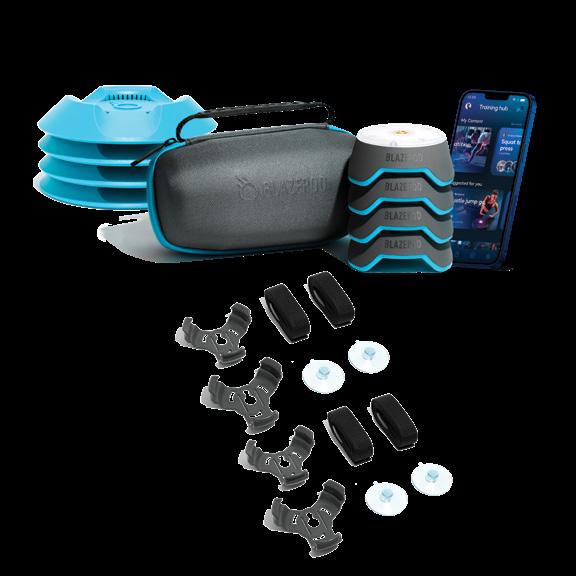

Blazepod Kit Set of 4 — Blazepod is a cutting-edge training system that improves physical and cognitive abilities across various domains. The user-friendly app provides access to expert-curated activities and tests, fostering innovation and challenge in your training regimen. Perfect for individuals, one-on-one coaching, and home workouts, BlazePod revolutionizes reaction time, agility, and decision-making skills. The two components are the mobile app and the control center directing touch-activated light-up pods. This innovative approach refines reactions to mirror instinctive reflexes, making it indispensable for sports, fitness, and recovery programs. $299
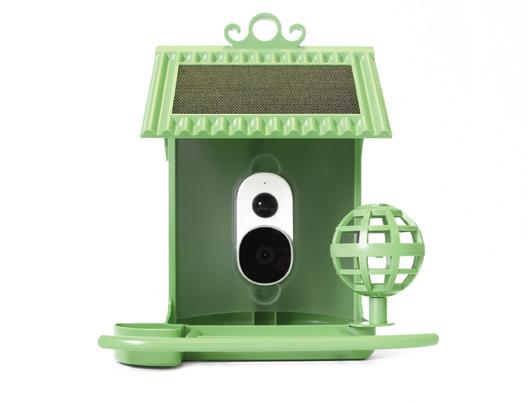
Hello Birdie — Hello Birdie is an intelligent bird feeder. Through its app, you’ll receive notifications of feathered guests, complete with identified species and stunning photos. Experience the joy of birdwatching from home while advanced AI technology keeps you informed about potential threats like squirrels. Hello Birdie ensures your backyard is a sanctuary of beauty and wildlife with the help of impressive tech. $210
220W Solar Blanket Bug Out Package — The 220W Solar Blanket Bug Out Package has Sunpower Gen 3 Solar Cells, having a 24.1% efficiency rating. Unlike other solar options that falter under 30% shade coverage, the product thrives in low light. Perfect for emergency preparedness, it charges vehicles, trailers, and stand-alone batteries. Plus, optional cables make it compatible with most portable power stations. It features high-speed USB and charging ports, making it versatile for various devices, including laptops. $2,185
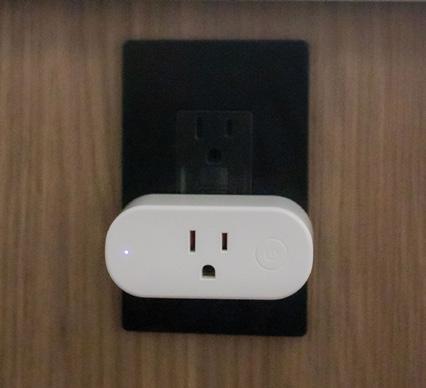
Shelly Plus Plug US — The Shelly Plus Plug US is a Wi-Fi-enabled smart plug equipped with power metering capabilities. The tech oversees and manages lighting, heating, or any other household electrical device, supporting up to 1800 watts at 15A. By connecting your regular space heater to Shelly Plus Plug US, you gain the convenience of remotely toggling it on and off with a simple click on your smartphone, regardless of your location. $20
INNOVATION & TECH TODAY | VOL. 9 / ISSUE 2 73 PRODUCT REVOLUTION

Withings Body Scan Connected Health Station — Withings
FDA-cleared Body Scan Connected Health Station includes the Scan Monitor 2.0, the first in the world to receive FDA clearance for detecting atrial fibrillation through a 6-Lead ECG. Body Scan empowers users to monitor their health biomarkers regularly, offering a daily analysis of indicators linked to common health conditions. By measuring segmental body composition, heart rate, and vascular age, it revolutionizes the smart scale category. In addition to detecting atrial fibrillation, the product also assesses nerve activity. $400

Elfin Pet Hydration System — The Elfin Pet Hydration System eliminates cleaning hassles with the NatureFlow system and ensures effortless maintenance with easy-todetach parts that can be rinsed directly with water. The MagDrive technology ensures water and electronics are completely separate, eliminating the risk of electric shocks. With dual-mode dispensing, intelligent flow management caters to your pet’s needs. With changing only needed every 30 days, the Elfin Pet Hydration System offers optimal convenience without hassle. $99

Leo’s Loo Too Covered Automatic Self-Cleaning Cat Litter Box — Leo’s Loo Too Covered Automatic Self-Cleaning Cat Litter Box is the connected version of the original flagship product that incorporates cutting-edge UV technology, eliminating up to 99.9% of bacteria. After each visit from your cat, it automatically sifts, ensuring cleanliness. The product includes triple-layer safety protection, odor-reducing UV light, and a sleek modern design. The accompanying app monitors usage patterns and offers customizable settings. Plus, it’s compatible with Alexa and Google Home. $650
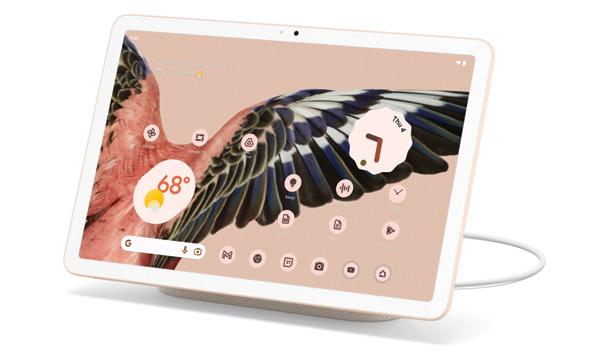
Pixel Tablet — The Google Pixel has an immersive 11-inch screen and a long-lasting adaptive battery, which offers unmatched entertainment. The tablet seamlessly integrates with Pixel phones and earbuds, giving you personalized assistance through Google Tensor G2. Enjoy integrated entertainment with Google TV, control your smart home effortlessly via the Google Home app, and experience the convenience of quick access to smart home controls. Plus, with Hub Mode, it transforms into a smart display, displaying photos, controlling your home, and offering hands-free help from Google Assistant. $499
74 INNOVATION & TECH TODAY | VOL. 9 / ISSUE 2
PRODUCT REVOLUTION
Gaming & Entertainment
6-in-1 Docking Station for Steam Deck & ROG
Ally — The multifunctional docking station by Syntech International Co. Limited has an innovative round base design. The minimalist design, which pairs perfectly with the Steam Deck and ROG Ally, breaks the stereotypes of the average square base look while enhancing support, stability, and performance by prohibiting vent blockage. With a smarter chip for high compatibility, quality meets performance with its additional extensibility to your gaming setup. $50

C SEED N1
TV — C SEED Entertainment
Systems offers the C SEED N1 TV, which is the object of singular refinement and a perfectly balanced match for classic and contemporary interior design environments. With its screen able to move 180 degrees left and right, rotation it adjusts smoothly. A sleek column rises silently from its base and settles down smoothly to provide the user with an overwhelming entertainment experience at the push of a button. $190,000

Connected Life

Trane Home App — Released by Trane Residential, the Trane Home App allows homeowners to remotely adjust their connected thermostats, set heating and cooling schedules, change lighting, manage appliances, control door locks and security systems, and more. By using this app, homeowners can have optimal control of their indoor comfort in a simplified and seamless way.
INNOVATION & TECH TODAY | VOL. 9 / ISSUE 2 75 PRODUCT REVOLUTION
Health Tech


SPRYNG — SPRYNG by MAS Design Inc. is an active pneumatic compression wrap designed to help improve circulation, athletic performance, and muscle recovery. It is an untethered, sleek, and affordable device. With its versatility, SPRYNG is an active pneumatic compression solution for anywhere. The 100% wireless device improves blood circulation, which helps the overall muscle recovery process. $200
NIMA Partners Gluten Sensor — The NIMA Partners Gluten Detection Sensor is a portable device designed to detect the presence of gluten in food. It uses proprietary antibody-based chemistry for detection with 97% accuracy. Innovation is at the user’s fingertips with its portability. With the small and compact device, it’s easy for users, especially individuals with celiac disease or gluten sensitivities, to carry it with them and test their food anywhere, anytime. $220
General Tech Products

T19Plus Car Battery Jump Starter — The CAROSS Model T19Plus 12V Jump Starter Box features a 2000 Amp Lithium battery, 3" smart digital screen, and PD 65W fast charge technology that charges the T19Plus in one hour. The portable power bank charges laptops, phones, drones, cameras, and more with a USB-C port, plug-and-play patented Smart Connect Technology. The T19 Plus packs plenty of power to start up to an 8-liter gasoline or 6-liter diesel engine in seconds. CAROSS’ patented Smart Connect Technology is the safest and simplest way to jump-start a vehicle. Attach either battery clamp to either battery post with no worry of any spark that can cause a fire if near flammable material, liquids, bodily harm, or damage to the vehicle’s ECU or electrical system. $170


SpotOn GPS Dog Fence — The SpotOn GPS Dog Fence offers dogs and owners a flexible and effective wireless dog fence. Powered by patented GPS technology, SpotOn is the easiest and most reliable way to maintain your dog’s safety. The tech device has a dedicated antenna that dynamically filters out poor GPS signals partially blocked. Use the coupon code TECHTODAY for $100 off. $1,295
76 INNOVATION & TECH TODAY | VOL. 9 / ISSUE 2 PRODUCT REVOLUTION

COMING NEXT ISSUE
After exploring the innovations of electric vehicles and connected cars, we’re eager to see what the industry will continue to do in the following months and years. It’s no secret that the world needs to be more environmentally conscious, and the tech discussed inside these pages can be the solution.
In addition to advancements in the automotive industry, smart home tech and emerging robotics are front and center. We’re excited to announce that Innovation & Tech Today will explore these trends in issue 9.3. Topics discussed in the upcoming issue include robotics in medicine, smart home technology, autonomous vehicle technology, metaverse possibilities, the ups and downs of AI, and more.
We’ll cover the Metaverse Spectrum Business Conference & Expo in issue 9.3. The 2023 Metaverse Spectrum Conference and Pitch Fest, which was in December 2023 in the metaverse, will cover a full range of business applications and developments in the metaverse, including marketing, product design, training, and human resources applications. Some of the more intriguing applications at the event include an industrial metaverse application for a prototype fusion energy plant in the UK and a gamified experience in the metaverse based on Cirque du Soleil’s location-based entertainment experiences.
We appreciate all of our readers and look forward to giving the inside scoop on smart home and robotic tech trends very soon! Stay tuned.

EVENTS
MAY
7-10 | Smart Cities Connect Conference & Expo | Raleigh Convention Center | Raleigh, NC
8-9 | Smart Retail Tech Expo | Las Vegas Convention Center | Las Vegas, NV, 13-15 | Space Tech Expo | Long Beach Convention Centre | Long Beach, CA,
JUNE
10-12 | FEI: Front End of Innovation 2024 | Omni Boston Hotel | Boston, MA
AUGUST
8-10 | 2024 World Battery & Energy Industry Expo | Guangzhou, China
SEPTEMBER
17-18 | 2024 Net Zero Conference | Anaheim Convention Center | Anaheim, CA
EVENTS AND SAVE!
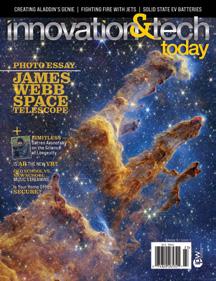
Save off the newsstand price and never miss a single issue of Innovation & Tech Today. Subscribe now and continue to get insightful coverage of all the new innovative tech!
Keep up with the latest in tech events. Bookmark the Innovation & Tech Today calendar and stay up to date.
SUBSCRIBE
78 INNOVATION & TECH TODAY | VOL. 9 / ISSUE 2
Photo: iStockphoto
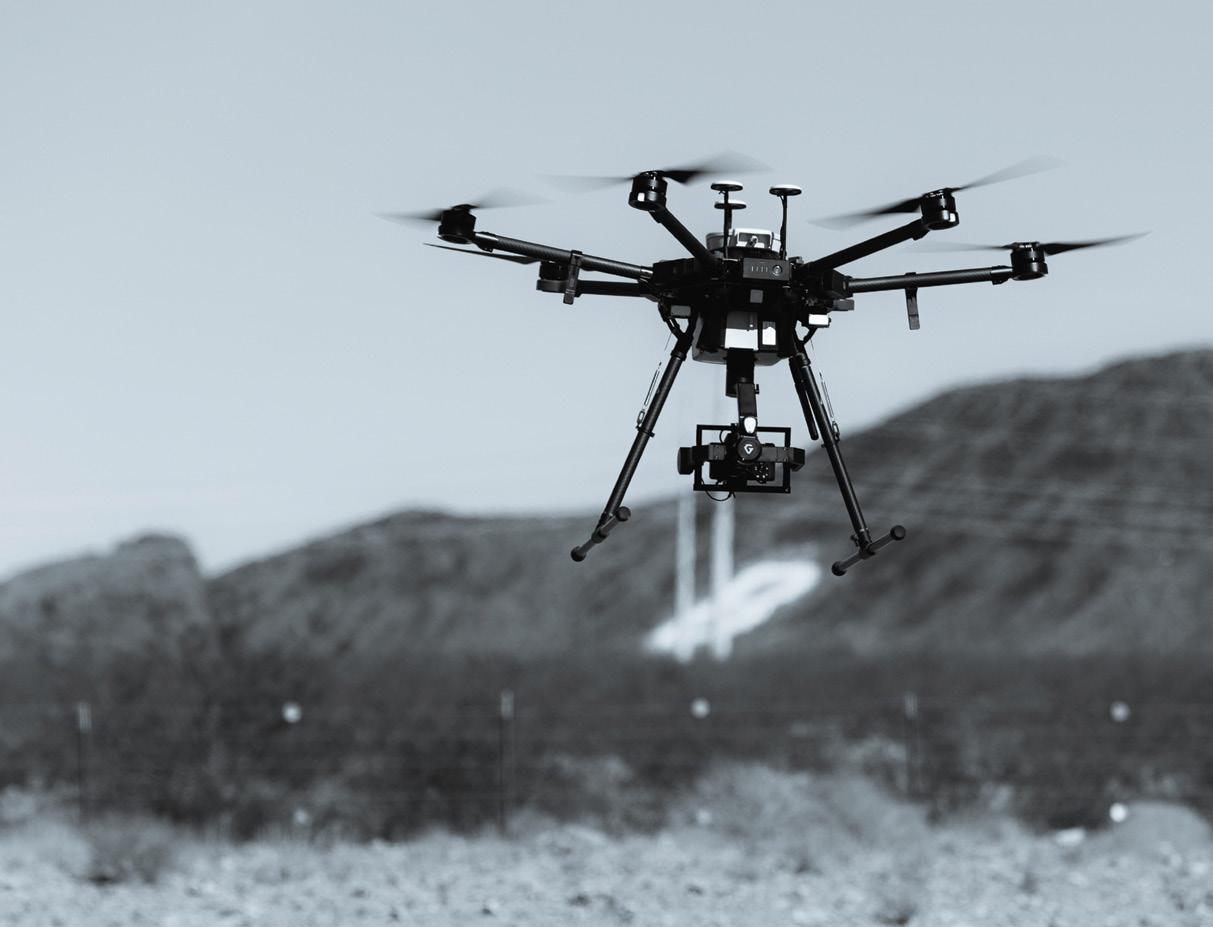

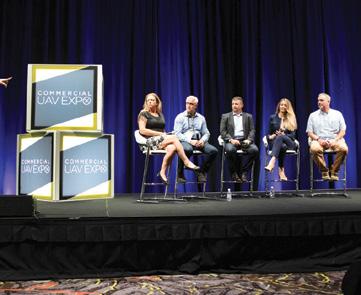
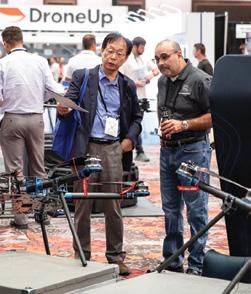
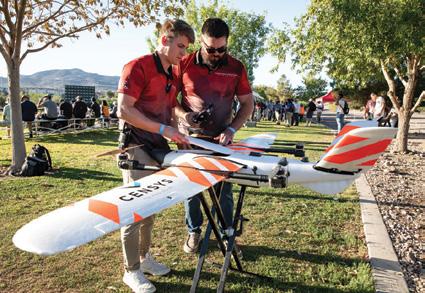
CONNECT
Expansive education program with solutions-oriented presentations & workshops from UAS thought-leaders
Facilitated networking with drone industry professionals from around the globe
Cutting-edge UAS solutions providers, live outdoor flying demonstrations & exclusive training

LEARN
EXPERIENCE
Produced by Diversified Communications Presented by: Official Association Partner: SEPT. 3-5, 2024 CAESARS FORUM / LAS VEGAS 10 th Edition Register at expouav.com
code
for
off a conference pass or a FREE exhibit hall pass
CURRENT
FUTURE
CO-LOCATED EVENTS:
Use
SAVE100
$100
DRONES IN ACTION
REALITIES &
FRONTIERS
The Lighter Side The Emoji Renaissance
By Lindsey Feth

The Future of Digital Connection
Emojis revolutionize communication in the digital space. No matter your native language, emojis are easy to understand. With many of them symbolizing nonverbal cues, they can convey your message with the right tone and emotion.
The emoji keyboard could even be called the new global language. It unites generations, cultures, and demographics to understand messages words can sometimes not convey.
THE EVOLUTION OF EMOJIS

The Beginning
In 1999, Japanese artist Shigetaka Kurita designed a set of pixel drawings known as some of the first emojis ever created. Kurita made these new emojis for Japan’s mobile carrier, NTT Docomo, for its mobile internet platform, i-mode. The term “emoji” was adopted as a combination of the Japanese words for “picture” and “letter.”


Emojis in 2024
New emojis are produced each year depending on what our society values. This will undoubtedly continue in the months and years to come. And with the widespread adoption of AI, we are now seeing a shift to personalized emoji creation.




TikTok’s Secret Language
The social media platform TikTok, which has taken digital engagement to a whole new level in recent years, has become a key player in emoji usage. With the platform’s firm grasp of new trends, it has embraced emojis and revolutionized how they are used and interpreted.
When put in a specific combination, emojis on TikTok can speak a secret language, so to speak, only avid users are aware of — which is a lot more users than some may assume. According to a study by Pew Research Center, 48% of U.S. adults aged 18 to 29 say they’ve used TikTok. Plus, researchers from the Massachusetts Institute of Technology have found that emojis make up about 20% of the text in the average TikTok comment section.
TikTok has also curated its platforms to use emojis as a guiding light for creating user algorithms to boost engagement. Even using specific combinations of emojis in a comment can let TikTok know if the videos posted are trending or relevant to current events, which results in For You Page presence.

New Emojis Coming Soon
iPhone users can expect new emojis in the spring of 2024. As of now, Apple plans to release an additional 118 emojis to their keyboard as part of a beta version of the new IOS 17.4, including four gender-neutral families, a phoenix, and a shaking head.
Customized Emojis With AI
In 2024, we can expect an increased use of personalized emojis created with artificial intelligence. Anyone can put their own spin on how their emojis look and what it’s doing, which makes messaging more unique than ever.
AI emoji generators are very accessible. For iPhone users, AI emoji generators such as Emojily and Zmoji are an easy way to create icons customized for specific social interactions. Android devices are more compatible with AI emoji generators such as Boomoji and Elite Emoji, which offer high-resolution imagery and avatars.
80 INNOVATION & TECH TODAY | VOL. 9 / ISSUE 2
Image courtesy of blog.emojipedia.org
Emojily / Photo via Apple Store
Above, Shigetaka Kurita accepting the Webby Lifetime Achievement award at The Webby Awards 2023 and his 5 word acceptance speech as done in emojis. Photo via video screenshot.

Dell Technologies and Intel are supporting scientists as they tackle one of the biggest challenges in conservation—protecting the coral reef. We are also helping small businesses everywhere manage their challenges, big and small. With the power to collect critical data, reduce IT complexities and keep systems secure, technology is helping businesses protect many environments. See what we can do for yours. Delivering


innovation to any environment. Including yours.
to Now
Intel® Innovation Built-in
Welcome
Explore more at Dell.com/WelcomeToNow








 Charles Warner, Publisher/ Editor-in-Chief
Charles Warner, Publisher/ Editor-in-Chief
























































































































































































 By Ashley Pearce & Lindsey Feth
By Ashley Pearce & Lindsey Feth



































































































































